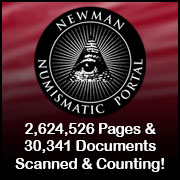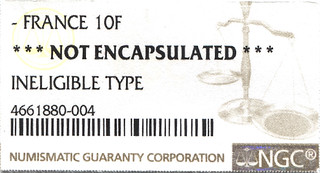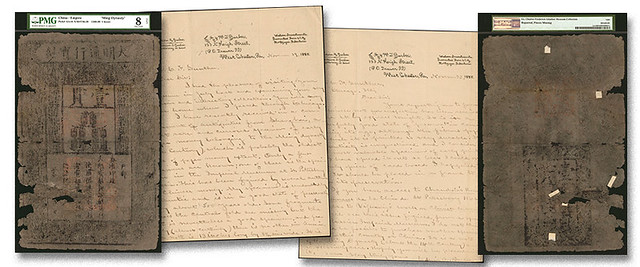
About UsThe Numismatic Bibliomania Society is a non-profit association devoted to the study and enjoyment of numismatic literature. For more information please see our web site at coinbooks.org SubscriptionsThose wishing to become new E-Sylum subscribers (or wishing to Unsubscribe) can go to the following web page link MembershipThere is a membership application available on the web site Membership Application To join, print the application and return it with your check to the address printed on the application. Print/Digital membership is $40 to addresses in the U.S., and $60 elsewhere. A digital-only membership is available for $25. For those without web access, write to: Charles Heck, Treasurer
AsylumFor Asylum mailing address changes and other membership questions, contact Chuck at this email address: treasurer@coinbooks.org SubmissionsTo submit items for publication in The E-Sylum, write to the Editor at this address: whomren@gmail.com BUY THE BOOK BEFORE THE COINSale Calendar |
- WAYNE'S WORDS: THE E-SYLUM FEBRUARY 9, 2020
- NEW BOOK: THE FRENCH OVERSEAS MEDALS
- NEW BOOK: A CULTURAL HISTORY OF CHINESE MONEY
- NEW BOOK: 50 ROMAN FINDS FROM THE PAS
- DIME PHOTOS SOUGHT FOR CHERRYPICKERS' GUIDE
- COLONIAL COINS YAHOO GROUP ON NEWMAN PORTAL
- VIDEO: AM I NOT A MAN AND A BROTHER TOKEN
- VIDEO: JANUARY 2020 FUN COIN CONVENTION
- 2020 NEWMAN GRANT PROGRAM ANNOUNCED
- CARSON CITY CELEBRATES MINT'S 150TH ANNIVERSARY
- CIVIL WAR ALLOTMENT CHECKS
- NOTES FROM E-SYLUM READERS: FEBRUARY 9, 2020
- COINS FOUND MUDLARKING ON THE THAMES
- NUMISMATIC MYSTERY ANSWER: EFREM ZIMBALIST III
- COIN OF THE YEAR CRITERIA
- VOCABULARY TERM: HUBBING PRESS
- GEORGE HILLIARD DAVIS (1836-1868)
- COIN-BUYING IN THE 1950S AND 60S
- JOHN THANE'S 1786 FREDERICK SALE INVOICE
- NATIONAL NUMISMATIC COLLECTION DIGITIZATION
- ANA SEMINAR ON WILLIAM AND CHARLES BARBER
- MORE HOLABIRD FEBRUARY 2020 SELECTIONS
- ARCHIVES INTERNATIONAL SALE #57 SELECTIONS
- GROUVILLE HOARD SETS WORLD RECORD
- MUSEUM RECOGNISES DETECTORIST CONTRIBUTIONS
- A 1795 SILVER-PLUGGED HALF DOLLAR
- INTERNATIONAL YEAR OF DISABLED PERSONS COINS
- ROYAL MINT ISSUES NEW FIVE KILO GOLD COIN
- PHIL MICKELSON'S GOLF BALL MARKER
- 15TH AMENDMENT BLACK SUFFRAGE MEDAL
- GEORGE MEDAL FOR SAVING PRINCESS ANNE
- A MING NOTE WITH HISTORICAL PROVENANCE
- BRISTOL POUND ON THE BRINK OF CLOSURE
- A HANDMADE BOOKSHELF
- LOOSE CHANGE: FEBRUARY 9, 2020
- HOARDER'S COTTAGE YIELDS £80,000 GOLD TREASURE
Click here to access the complete archive
Click here to unsubscribe (scroll down)
To comment or submit articles, reply to whomren@gmail.com
Content presented in The E-Sylum is not necessarily researched or independently fact-checked, and views expressed do not necessarily represent those of the Numismatic Bibliomania Society.
WAYNE'S WORDS: THE E-SYLUM FEBRUARY 9, 2020
 New subscribers this week include: Brian Alty of Northeast Numismatics, courtesy of Tom Caldwell; Vera Duzhak of Ukraine, courtesy of Adrián González-Salinas of Monterrey, N.L. México; and
Ron Confortin. Welcome aboard! We now have 6,083 subscribers.
New subscribers this week include: Brian Alty of Northeast Numismatics, courtesy of Tom Caldwell; Vera Duzhak of Ukraine, courtesy of Adrián González-Salinas of Monterrey, N.L. México; and
Ron Confortin. Welcome aboard! We now have 6,083 subscribers.
Thank you for reading The E-Sylum. If you enjoy it, please send me the email addresses of friends you think may enjoy it as well and I'll send them a subscription (but let me know if they are located in the European Union). Contact me at whomren@gmail.com anytime regarding your subscription, or questions, comments or suggestions about our content.
This week we open with three new books, a search for photos, updates from the Newman Numismatic Portal and Eric P. Newman Numismatic Education Society, the the Carson City mint celebration.
Other topics this week include Civil War allotment checks, coins found mudlarking, Coin of the Year criteria, hubbing presses, coin buying in the 1950s and 60s, digitizing the National Numismatic Collection, selections from the Holabird and Archives International sales, the Grouville hoard, a silver plugged half dollar, the 15th amendment medal, and the Bristol Pound.
To learn more about French overseas medals, the "Am I Not a Man and A Brother" token, the Louis XIII Double Tournois copper, non-circulating legal tender coinage, George Hilliard Davis' 1793 Chain Cent, Mint engravers William and Charles Barber, shell cards, the 1879 Hawaii Silver Certificate of Deposit, the Montreal British Milita token, and the International Year of Disabled Persons series, read on. Have a great week, everyone!
Wayne Homren
Editor, The E-Sylum
NEW BOOK: THE FRENCH OVERSEAS MEDALS
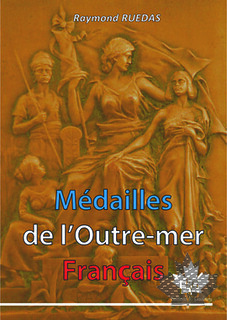 Gadoury has published a new book by Raymond Ruedas on French overseas medals. There's little information on the web site, but here are the cover and sample pages. What is the time
period covered? I wonder if medals relating to French colonies on America are covered. -Editor
Gadoury has published a new book by Raymond Ruedas on French overseas medals. There's little information on the web site, but here are the cover and sample pages. What is the time
period covered? I wonder if medals relating to French colonies on America are covered. -Editor
MÉDAILLES DE L'OUTRE-MER FRANÇAIS
Author: Raymond RUEDAS
Publisher: GADOURY
Year: 2020
Language:
€ 59.00
More than 700 pages, this book lists more than 300 years of medals across the former colonies, territories and departments of French Overseas. Delivery from February 20
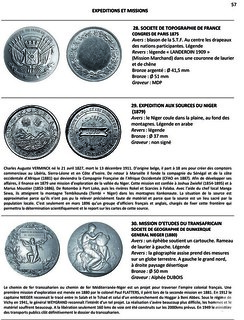
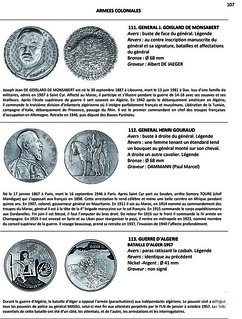
For more information, or to order, see:
MÉDAILLES DE L'OUTRE-MER FRANÇAIS (https://www.gadoury.com/en/books/medailles-de-l-outre-mer-francais)
THE BOOK BAZARRE
NEW BOOK: A CULTURAL HISTORY OF CHINESE MONEY
Well, it was published in 2011, but it's new to us. In her Chinese Money Matters blog, Helen Wang, Curator of East Asian Money at The British Museum discussed this book on the cultural history of Chinese money. -Editor
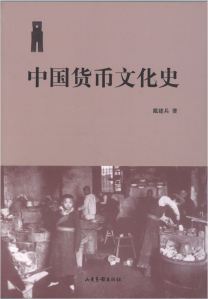 Many thanks to Prof Dai Jianbing for presenting this book to the Dept of Coins and Medals at the British Museum:
Many thanks to Prof Dai Jianbing for presenting this book to the Dept of Coins and Medals at the British Museum:
DAI Jianbing, Zhongguo huobi wenhua shi [A Cultural History of Chinese Money] (Jinan: Shandong huabao chubanshe, 2011. ISBN 978-7-5474-0146-0
Table of Contents
Ch.1 The birth of Chinese money, and money of the Spring and Autumn, and Warring States periods (p.1)
- The birth of Chinese money (p.3)
- Money of Spring and Autumn, and Warring States periods (p.7)
Ch.2 Money of the Qin and Han periods (p.17)
- Unification of money during the Qin (p.19)
- Western Han money (p.21)
- Wang Mang's coinage reforms (p.25)
- Eastern Han money and Han dynasty gold money (p.29)
Ch.3 Interaction between the money cultures of China, ancient Greece and Rome (p.33)
- Alexander the Great's legacy in coins (p.35)
- Indo-Bactria (p.39)
- Lead ingots with foreign inscriptions - the three-white-metal pieces (p.45)
- Coins from Rome (p.47)
Ch.4 Money of the Three Kingdoms, Two Jin, and Northern and Southern Dynasties (p.49)
- Three Kingdoms money (p.51)
- Coins of the Two Jin and Sixteen Kingdoms (p.54)
- Coins of the Northern and Southern Dynasties (p.57)
Ch.5 Money of the Sui, Tang, Five Dynasties and Ten Kingdoms (p.63)
- The monetary system of the Sui, Tang, Five Dynasties and Ten Kingdoms (p.65)
- The westward movement of Tang dynasty money culture (p.73)
- Interaction between money cultures of the Tang and Western Asia (p.76)
Ch.6 Song dynasty money (p.79)
- Bronze and iron coins of the Northern and Southern Song (p.82)
- The birth and development of Song dynasty paper money (p.86)
Ch.7 Liao, Xia, Jin and Yuan dynasty money (p.93)
- Liao money (p.95)
- Xi Xia money (p.98)
- Jin money (p.100)
Ch.8 Yuan dynasty money (p.105)
- Varieties of Yuan dynasty money (p.105)
- Persian paper money and the Arabification of Mongol khanate coins (p.113)
Ch.9 Ming dynasty money (p.117)
- Da Ming tongxing baochao (Ming paper money) (p.119)
- Silver (p.122)
- Ming and late Ming coins (p.125)
Ch.10 The Asian money cultural sphere, with China at the centre (p.133)
- China and Japan (p.136)
- China and Korea (p.139)
- China and Vietnam (p.142)
- China and South East Asian countries (p.145)
Ch.11 Money in the early Qing dynasty (p.149)
- Managing a copper-based coinage across the country (p.151)
- Qing dynasty cash coins (p.158)
- Qing dynasty silver (p.169)
- Exchange rates between silver and cash coins, and unofficial practices (p.174)
- Money cultures in Xinjiang, and interaction with foreign money cultures (p.182)
Ch.12 Copper dollars and silver dollars of the modern period (p.191)
- Foreign silver dollars and their influence on Chinese money culture (p.193)
- The course of China copying foreign silver dollars (p.199)
- Cash coins and copper dollars in the modern period (p.203)
- The transition from silver ingots to silver dollars (p.209)
- Copper dollars and silver dollars in the Republican period (p.225)
Ch.13 Paper money of the modern period (p.247)
- A general survey of paper money (p.249)
- A kaleidoscope of paper money (p.262)
Ch.14 Paper money issued by the government and banks in the modern period (p.273)
- Government-issued notes (chaopiao) (p.275)
- The circulation of foreign banknotes in China (p.278)
- Notes issued by national banks (p.285)
- Notes issued by commercial banks (p.293)
- Notes issued by provincial and regional banks in the Republican period (p.302)
Ch.15 The evolution of the monetary system in the modern period (p.313)
- A monetary system based on silver (p.315)
- From the late Qing Rules of Coinage to replacing the liang with the yuan (p.318)
- The policy on "fabi" (legal currency) and national finance (p.322)
- Currency war between China and Japan (p.329)
- Fake currency, gold yuan notes and the collapse of the monetary system (p.337)
Ch.16 Monetary finance in the revolutionary base areas and the establishment of the renminbi system (p.345)
- The birth of the financial system in the revolutionary base areas (1927-1937) (p.347)
- The development and expansion of the financial system of the New Democracy Movement (1937-1945) (p.350)
- The victory of the New Democracy Movement's financial system across the whole country (1945-1949) (p.361)
Appendix (p.371)
- Carriers of popular culture - coin-shaped charms (p.373)
To read the complete article, see:
71. BOOK: A CULTURAL HISTORY OF CHINESE MONEY
(https://chinesemoneymatters.wordpress.com/2020/02/07/72-book-a-cultural-history-of-chinese-money/)

NEW BOOK: 50 ROMAN FINDS FROM THE PAS
Mentioned in an article forwarded this week by David Sundman is this new book on Roman finds (including coins) from the Portable Antiquities Scheme. -Editor
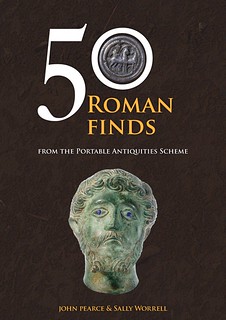 50 Roman Finds From the Portable Antiquities Scheme highlights some of the most important and interesting Roman objects recorded by the Portable Antiquities Scheme (PAS) or reported
as Treasure. It features a wide variety of objects, allowing for a balanced presentation of both well-preserved everyday objects and some of the most spectacular finds to have been recorded by the
PAS. Iconic objects featured here include the Crosby Garrett helmet and the Ilam pan.
50 Roman Finds From the Portable Antiquities Scheme highlights some of the most important and interesting Roman objects recorded by the Portable Antiquities Scheme (PAS) or reported
as Treasure. It features a wide variety of objects, allowing for a balanced presentation of both well-preserved everyday objects and some of the most spectacular finds to have been recorded by the
PAS. Iconic objects featured here include the Crosby Garrett helmet and the Ilam pan.
Collectively, the fifty examples featured here exemplify the cosmopolitan culture of the Roman world and help shed further light on a fascinating period of British history.
Book ISBN: 9781445686844
Book Format: Paperback
Pages: 96 pages
Publication Date: 15 Feb 2020
Height: 234
Width: 165
Illustrations: 150
For more information, or to order, see:
50 ROMAN FINDS FROM THE PORTABLE ANTIQUITIES SCHEME
(https://www.amberley-books.com/50-roman-finds-from-the-portable-antiquities-scheme.html)
DIME PHOTOS SOUGHT FOR CHERRYPICKERS' GUIDE
Dennis Tucker of Whitman Publishing put out this call for dime photographs for the new Cherrypickers' Guide. Can anyone help? Pictured is the Fifth Edition, Volume 1. -Editor
Liberty Seated, Barber, Mercury, and Roosevelt Dime Photographs Sought for New Cherrypickers' Guide
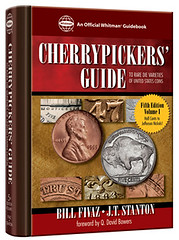 Whitman Publishing will release the newest volume of the Cherrypickers' Guide to Rare Die Varieties of United States Coins at the August 2020 World's Fair of Money in Pittsburgh. The
book's editors are now seeking photographs of certain die varieties of United States dimes, 1837 to date. Collectors and dealers who seek to assist may email cherrypickers@whitman.com.
Whitman Publishing will release the newest volume of the Cherrypickers' Guide to Rare Die Varieties of United States Coins at the August 2020 World's Fair of Money in Pittsburgh. The
book's editors are now seeking photographs of certain die varieties of United States dimes, 1837 to date. Collectors and dealers who seek to assist may email cherrypickers@whitman.com.
“Cherrypicking” in the coin-collecting hobby means to examine a coin that appears normal at first glance, looking for unusual characteristics—like doubled and tripled dies, overdates, and repunched mintmarks—that reveal it to be rare and valuable. In the Cherrypickers' Guide, close-up photographs and text descriptions instruct the reader in what to look for. The book includes rarity ratings, market analysis, and retail values.
Edits and updates for the new volume are being coordinated by Cherrypickers' Guide coauthor Bill Fivaz and professional numismatist Larry Briggs.
“Within the ten-cent denomination, we're down to a small number of varieties we still need good images for,” Fivaz said. “Photo contributors will be listed in the book's acknowledgments, with our thanks.”
Collectors and dealers who have clear, high-resolution photographs to share—or coins that can be photographed—may contact the Cherrypickers' Guide team by email at cherrypickers@whitman.com, for a list of specific needs.
Cherrypickers' Guide to Rare Die Varieties of United States Coins, sixth edition, volume II.
By Bill Fivaz and J.T. Stanton; forewords by Kenneth Bressett and Q. David Bowers; edited by Larry Briggs.
Publication date: August 2020. Retail price, page count, and other details to be announced.

COLONIAL COINS YAHOO GROUP ON NEWMAN PORTAL
The latest addition to the Newman Numismatic Portal is an archive of the Yahoo Colonial Coins Discussion Group. Project Coordinator Len Augsburger provided the following report. -Editor

Newman Portal Archives Yahoo Colonial Coins Discussion Group
Yahoo.com hosted hundreds of message groups dedicated to coin collecting, from the launch of the Yahoo Groups service in 2001 until recently, when Yahoo announced that all groups were being converted into email distribution lists. The C4 colonial coin collectors group in particular generated significant traction with many recognized experts regularly posting to their group. Over 100,000 posts were made to the C4 group, and these are now archived on Newman Portal. These may be searched via the Newman Portal advanced search page by first selecting “articles” as the content type and then entering a search phrase. For example, a search on “18-l” (a rare Maris variety in the New Jersey copper series) delivers 77 posts related to the subject. Newman Portal acknowledges C4 member Craig McDonald for his assistance with this project.
Newman Portal is interested in working with other Yahoo coin collecting groups to similarly archive their content. Contact NNPCurator@wustl.edu for more information.
Link to Newman Portal advanced search page:
https://nnp.wustl.edu/library/advancedsearchform
VIDEO: AM I NOT A MAN AND A BROTHER TOKEN
Newman Numismatic Portal Project Coordinator Len Augsburger provided this overview of the latest video in the Getting to Know Eric P. Newman series. -Editor
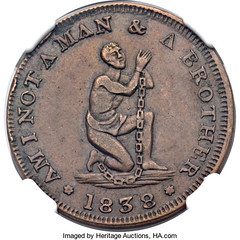
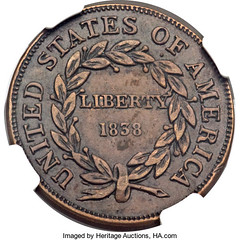
Getting to Know Eric P. Newman, Part 2: Am I Not a Man and Brother
Lianna Spurrier has created the second (of five) videos in the Getting to Know Eric P. Newman series on Newman Portal. Apropos of Black History Month, this video covers Newman's paper “The Promotion and Suppression of Hard Times Tokens,” from the 1995 Coinage of the Americas Conference proceedings, which centered on the AM I NOT AND BROTHER American hard times token (Low-54A). Spurrier intersperses video of Newman discussing his research at the 1989 ANA convention (video captured at the time by David Lisot) and explains the rarity of the piece, noting that only four examples are known. The real treasure hunt here is Newman's quest to discover the origin of the piece, ultimately uncovered in a 19th century anti-slavery newspaper following an extensive search.
Image: AM I NOT A MAN AND BROTHER hard times token, Low-54A (courtesy Heritage Auctions, 6/2016, lot 98196, realized $70,500), ex. Eric P. Newman Numismatic Education Society
Link to Getting to Know Eric P. Newman, Part 2 video on NNP:
https://nnp.wustl.edu/library/book/574413
Link to video of Newman's 1989 ANA presentation, Promotion & Suppression of Hard Times Tokens:
https://nnp.wustl.edu/library/book/544892
Link to the ANS Coinage of the Americas Conference Proceedings (1995):
https://nnp.wustl.edu/library/book/512500

VIDEO: JANUARY 2020 FUN COIN CONVENTION
These are selections from the David Lisot Video Library that feature news and personalities from the world of coin collecting. David has been attending coin conventions since 1972 and began
videotaping in 1985. The Newman Numismatic Portal now lists all David's videos on their website at:
https://nnp.wustl.edu/library/multimediadetail/522852
Here's one on the recent Florida United Numismatists Coin Convention. -Editor
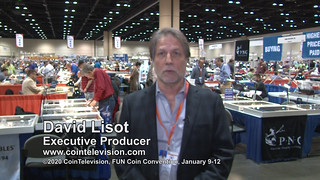 David Lisot Walk About FUN Coin Convention 2020.
David Lisot Walk About FUN Coin Convention 2020.
David Lisot, Host, CoinTelevision.com.
Numismatist David Lisot walks around the Florida United Numismatists Coin Convention and sees FUN President Bob Hurst, Ben Franklin, Abe Lincoln, numismatic exhibits and lots of coins!
An excerpt of the video is available for viewing on the Coin Television YouTube Channel at:
https://www.youtube.com/watch?v=nljemeb_-7g
2020 NEWMAN GRANT PROGRAM ANNOUNCED
Newman Numismatic Portal Project Coordinator Len Augsburger submitted this announcement of the 2020 Eric P. Newman Numismatic Education Society (EPNNES) Newman Grant Program. Thanks. -Editor
Eric P. Newman Numismatic Education Society Announces 2020 Newman Grant Program
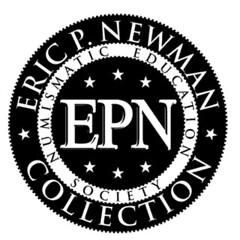 The Eric P. Newman Numismatic Education Society (EPNNES) solicits grant applications for its 2020 Newman Grant program. EPNNES seeks to make awards that promote original research in
American numismatics, through the sponsorship of travel and related research expenses. Newman Grant awardees for 2019 included Chris McDowell, who created a census of all known Pitt farthings. Newman
Grant awardees allow non-exclusive publication of their research on Newman Numismatic Portal. Applications will be accepted until April 1, 2020, with awards to be announced on May 25, 2020, in
commemoration of Eric P. Newman's birthday.
The Eric P. Newman Numismatic Education Society (EPNNES) solicits grant applications for its 2020 Newman Grant program. EPNNES seeks to make awards that promote original research in
American numismatics, through the sponsorship of travel and related research expenses. Newman Grant awardees for 2019 included Chris McDowell, who created a census of all known Pitt farthings. Newman
Grant awardees allow non-exclusive publication of their research on Newman Numismatic Portal. Applications will be accepted until April 1, 2020, with awards to be announced on May 25, 2020, in
commemoration of Eric P. Newman's birthday.
Link to 2020 Newman Grants application and press release:
https://nnp.wustl.edu/library/archivedetail/530553?Year=2020
Link to Chris McDowell study on Pitt farthings:
https://nnp.wustl.edu/library/booksbyauthor/534073
A lot of great research is coming out of last year's grants. I expect we'll see more of the same in the 2020 program. Follow the link for more information, and consider applying. -Editor
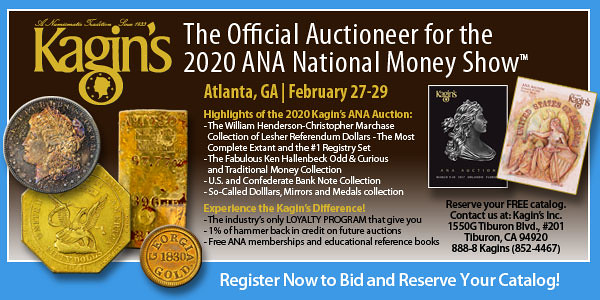
CARSON CITY CELEBRATES MINT'S 150TH ANNIVERSARY
The Carson City Mint sesquicentennial celebration was held on February 4th, 2020. Visiting dignitaries including U.S. Mint Director David Ryder participated. Here's a short report and a couple photos courtesy David Elliott of Reno, NV. Thanks! -Editor
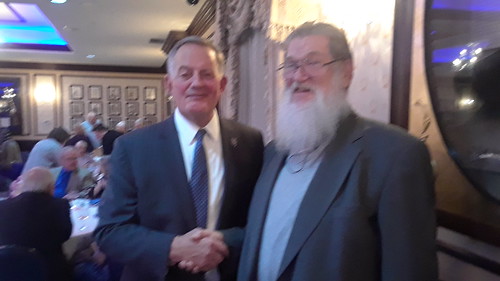
Director Ryder and David Elliott
Reno Coin Club and president David Elliott celebrated the 150th anniversary of the Carson City Mint and Coin Press #1 with David Ryder, Director of the US mint. In addition to minting a new coin with Abe Curry, the mint, and the press, David Ryder signed all the newly minted coins and told us what is in store for the mint. Final approval from Treasury Department is waiting, but we will get a W nickel in all the mint sets this year. Remember the e-mail campaign I started last year to get that, so we will have all denominations with a W now. The 2 million W quarters will have a special countermark noting the 75th anniversary of WWII. There will also be a special set of commemorative coins for WWII in addition to the 400th anniversary of the Mayflower. Next year we will see the new Washington quarter with the crossing the Delaware reverse followed by 26 quarters featuring famous women. In 2026 there will be new reverse designs on all circulating quarters to celebrate our 250th anniversary followed by quarters focused on youth sports as a build up to the 2028 Olympics.
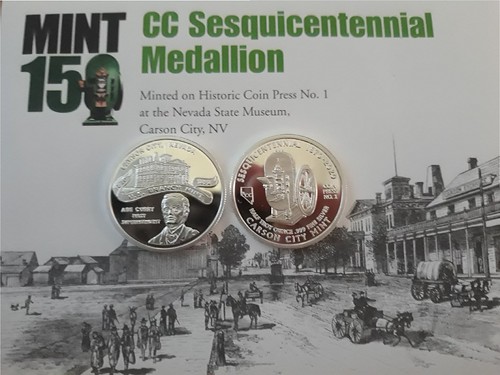
Here's an excerpt from a Nevada Appeal story about the event. -Editor
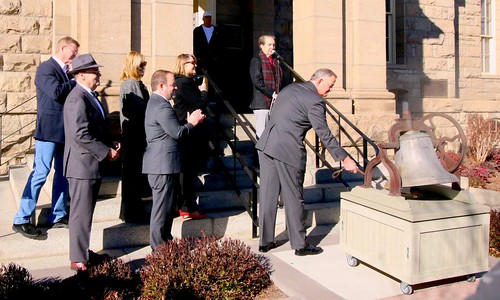
The Nevada State Museum demonstrated to the public on Tuesday that maintaining coinage mint will never go out of style in its sesquicentennial celebration of the Carson City Mint.
Gov. Steve Sisolak, Lt. Gov. Kate Marshall, U.S. Rep. Mark Amodei, U.S. Mint Director David Ryder and other local dignitaries joined in the 150th anniversary that included opening remarks from Carson City Mayor Bob Crowell, a keynote address from Ryder, tours of the Mint building and first strikes of the sesquicentennial medallion on Coin Press No. 1.
Crowell opened the day with remarks along with Ryder, who rang a bell crafted by the W. T. Garratt Co. of San Francisco that was rung to mark the opening of the business day of the mint. Crowell then invited the public into the Mint building, which was opened by the museum for tours to witness strikes of the new medallion.
Myron Freedman, director of the Nevada State Museum, said Carson City holds a special historical significance by maintaining the original Mint with an original coin press.
The sesquicentennial celebration, planned by the museum staff for more than two years, included the issuance of a special medallion die sculpted by former U.S. Mint engraver Tom Rogers.
The Carson Mint originally operated between 1870 to 1893. It produced nearly $50 million in face value of gold and silver coins, including gold double eagles, or $20, and eagles, or $10, and half eagles, or $5, as well as silver dollars, half dollars, quarters, dimes and 20-cent pieces.
Jim Markle, a coin press operator playing an historical interpreter Tuesday, said Coin Press No. 1 made an arduous journey from Philadelphia to Carson City, routed through the East Coast and Panama by rail, wagon and ship, finally arriving in 1869. The Transcontinental Railroad wasn't fully formed at that time. The machine, the only of its kind for the first five years, produced 100 coins per minutes.
“I think one of the real stories is the women who worked on the machine,” he said. “They were the ones who made sure that everything fit in the machine, no matter whether it was gold or silver.”
To read the complete article, see:
Carson City celebrates Mint's 150th anniversary
(https://www.nevadaappeal.com/news/carson-city/carson-city-celebrates-mints-150th-anniversary/)
To read the earlier E-Sylum article, see:
CARSON CITY MINT SESQUICENTENNIAL CELEBRATIONS (https://www.coinbooks.org/v23/esylum_v23n04a19.html)

CIVIL WAR ALLOTMENT CHECKS
Syd Martin submitted this response to Michael Atkins' query. Thanks! -Editor
With respect to Michael Atkins' article in the recent E-Sylum, which pictured an “Allotment Check” requesting additional information, I submit the following. An Allotment Check allowed a civil war soldier to send a portion (the allotment) of his pay directly to someone else (generally his wife or parents).
According to: https://en.wikipedia.org/wiki/Allotment_Commission_(United_States_Civil_War )
“The Allotment Commission was a quasi-governmental agency of the federal government of the United States during the Civil War. It was established by an act of Congress on December 24, 1861. It was a voluntary program whereby 1/3 of a participating Union soldier's pay was sent home to family and friends. The purpose was to prevent wasteful spending among idle and bored soldiers in camp.”
They appear to have been issued by several (if not all) of the Union states, and by both the Army and Navy.
A copy of one in my collection is:
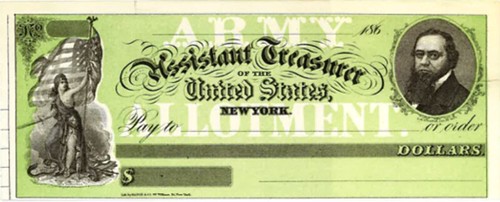
My New York, Army Allotment check is virtually identical to the one in The E-Sylum except that it features the bust of Edwin Stanton, Secretary of War. However, mine still has the stub attached at the left side:
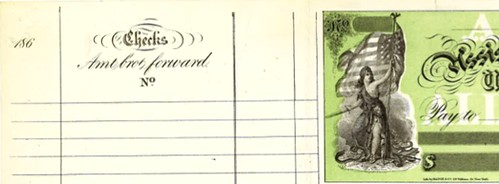
As these checks would have been returned to the issuing authority after being cashed, they were likely held for a period and then simply destroyed.
Such allotments have been used by the military ever since the Civil War for any number of reasons (e.g., to family, paying off a debt). I remember when my mother used to get “Allotment Checks” while my father was stationed in Korea during the Korean War.
To read the earlier E-Sylum article, see:
QUERY: A BLANK CIVIL WAR PAYCHECK (https://www.coinbooks.org/v23/esylum_v23n05a13.html)

NOTES FROM E-SYLUM READERS: FEBRUARY 9, 2020
Query: What Is This?
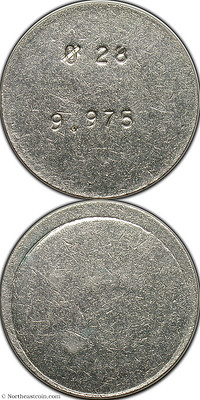 Tom Caldwell of Northeast Numismatics writes:
Tom Caldwell of Northeast Numismatics writes:
Maybe an E-Sylum reader can tell us what this piece is. NGC did not really fully explain.
Hmmmm. Labeled as "FRANCE 10F INELIGIBLE TYPE", I'm not sure what this is, or just what the numbers mean. Is it some sort of trial planchet? -Editor
Photo Captions with Clifford Mishler and David Alexander
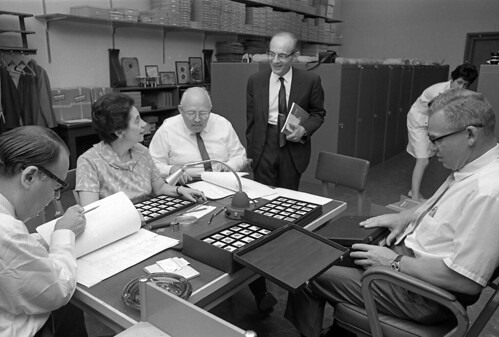
Clifford Mishler writes:
"I'm in agreement that the profile on the left certainly appears to me to be that of Hans Schulman, as Ken Bressett suggests."
"I also agree which Ken's observation that the profile on the right is not that of Abe Kosoff."
"The latter profile appears to me to quite likely be that of Charles Hoskins, later curator of the Detroit National Bank numismatic exhibit."
David T. Alexander writes:
"The photo of the Clain-Stefanellis and the late Hans M.F. Schulman is indeed puzzling. I believe that the figure at the right, across from Elvira is the late Carl W. Carlson, who may have still been curator of the Garrett Collection at the Johns Hopkins University in Baltimore. Carl spent his later years as a lead cataloger at Stack's, where I worked with him in the early 1990's. A true genius-level numismatist, Carl had an amiable ego, "I'm a Mensa member, you know!"
Thanks. This photo has been a puzzle - we've gotten consensus on most of the people pictured, but the last one is still a mystery. -Editor
To read the earlier E-Sylum articles, see:
THE CLAIN-STEFANELLIS AT THE SMITHSONIAN (https://www.coinbooks.org/v23/esylum_v23n04a15.html)
NOTES FROM E-SYLUM READERS: FEBRUARY 2, 2020 : Photo Captions with Ken Bressett
(https://www.coinbooks.org/v23/esylum_v23n05a11.html)
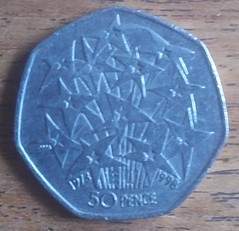 1998 25-year Britain in EU 50p Commemorative
1998 25-year Britain in EU 50p Commemorative
David Pickup writes:
I found a commemorative 50p in the church collection last Sunday, two days after Brexit. It was issued in 1998 to commemorate the 25th anniversary of Britain's accession to the EEC in 1973. Do you think someone had been keeping it but decided to give it away or is it just coincidence?

COINS FOUND MUDLARKING ON THE THAMES
Anne E. Bentley, Massachusetts Historical Society Curator of Art & Artifacts writes:
"I follow Liz Anderson on Twitter because she finds some remarkable things mudlarking!"
Thanks. Here are a few excerpts. -Editor
Mini thread about coins I've found while mudlarking on the Thames. Earlier in the week I found my second Louis XIII Double Tournois copper coin from 1640. A bit battered but fleurs-de-lis on the reverse more recognisable than many corroded newer coins I find.
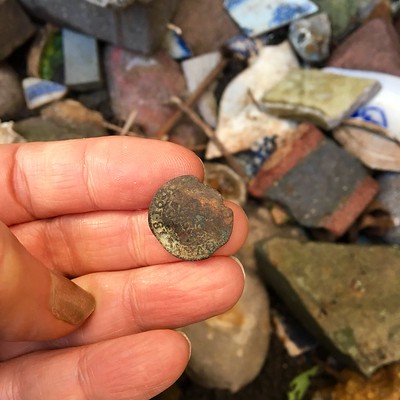
Louis XIII was King of France from 1610-1643, the eldest son of Marie de' Medici & Henry IV of France. The day I found this coin a young couple, leaning against railings on the Embankment above the foreshore, stopped to ask me what I was doing.
They came down onto the foreshore so we could chat. I found out they were from Paris & we spent the next 15 minutes chatting about ‘Le Mudlarking', me in my A level French struggling with the subjunctive. They were delightful & I gave them the Tournois coin.
It's a challenge finding coins on the river. I don't metal detect so everything coin-like is found by eye only. I didn't find my first coin until the second year of larking & by this time I'd learnt where to look
George V and VI coins are common finds at low tide. This is a George V (King from 1910-1936), the King's head on the obverse is faded & worn, Britannia on the reverse has faded into nothing. I hope this isn't an omen of doom for the future...
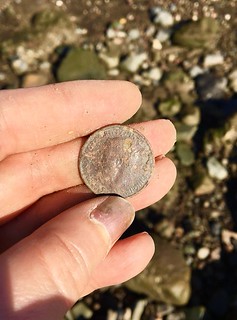
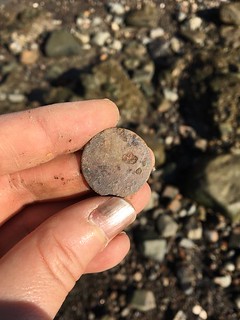
In contrast, this George II (1727-1760) halfpenny is in good condition after 300 years in anaerobic Thames mud. The obverse shows the ‘older head' of the King, often the monarch's face has been worn to nothing because people rubbed this side for good luck.
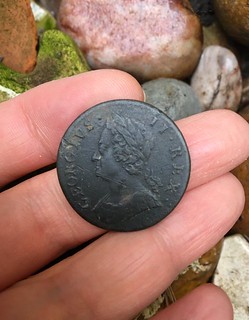
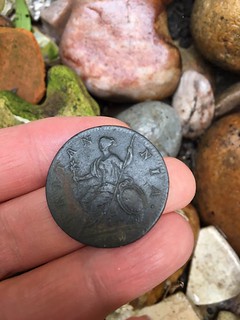
To read the complete tweets, see:
Mini thread about coins I've found while mudlarking on the Thames.
(https://twitter.com/liz_lizanderson/status/1222886763816943617?s=11)
NUMISMATIC MYSTERY ANSWER: EFREM ZIMBALIST III
Last week Pete Smith presented this quiz for our readers: "Who is the man pictured on the right and what is his role in current numismatics?" -Editor
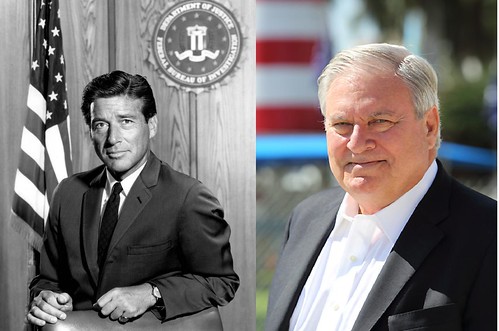
ANA Edition reader Robert Luton writes:
The images show Efrem Zimbalist Jr playing Lewis Erskine of the FBI and his son Efrem Zimbalist III, who founded Active Interest Media in 2003 and last year acquired several collectibles magazines including Coins.
Rex Stark of Gardner, Massachusetts writes:
The man on the left is the famous actor Efrem Zimbalist, Jr, shown in his tremendously popular television series The FBI (1965-1974). The man on the right is his son Efrem Zimbalist III, founder of Active Interest Media. The company is a major mover in marketing services, PR campaigns, trade shows and magazine publishing. They purchased a number of previous Krause titles in the bankruptcy of F+W Publications, including Numismatic News.
Mr. Zimbalist is no longer at the head of AIM - the current CEO is Andy Clurman. He founded the company with Zimbalist in 2003, taking the helm in 2015.
Pete Smith adds:
Zimbalist is the contemporary equivalent to Chester Krause, although much less well known in numismatics. There is an interesting parallel in their interests. Chester Krause ran old car shows in Iola, Wisconsin. Efrem Zimbalist III runs boat shows in Miami, Palm Beach, and Fort Lauderdale.
Thanks, everyone - great quiz. -Editor
To read the earlier E-Sylum article, see:
NOTES FROM E-SYLUM READERS: FEBRUARY 2, 2020 : Quiz: A Numismatic Mystery (https://www.coinbooks.org/v23/esylum_v23n05a11.html)
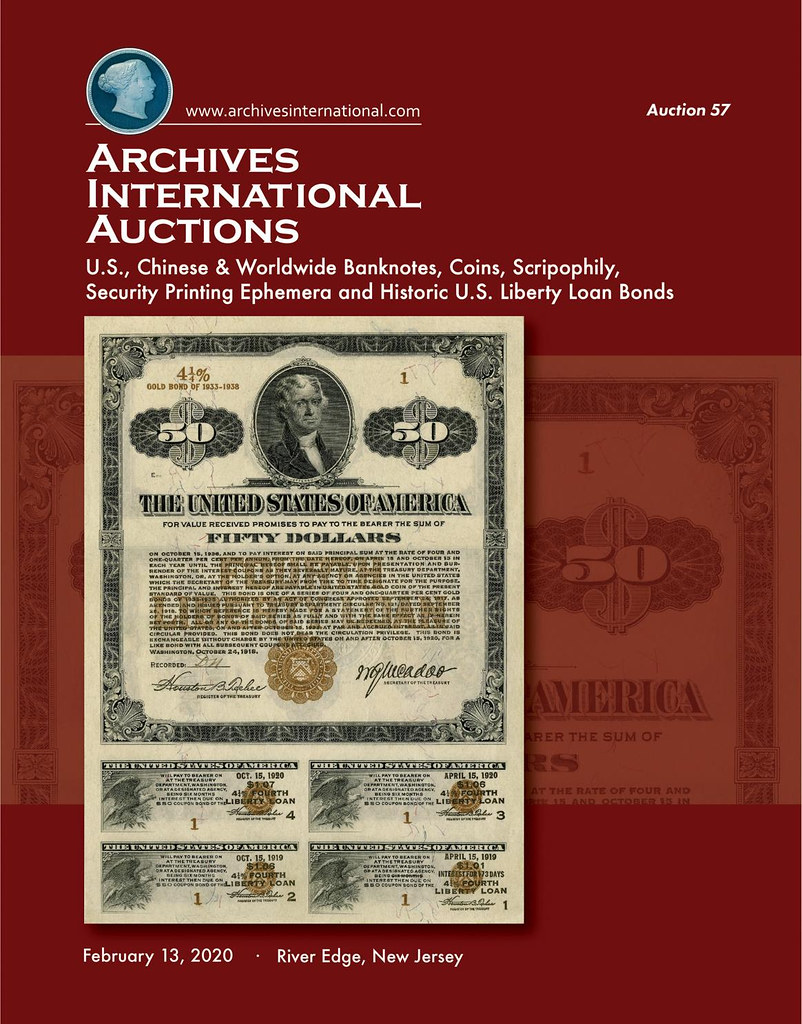
COIN OF THE YEAR CRITERIA
Regarding the 2020 Coin of the Year, John Regitko writes:
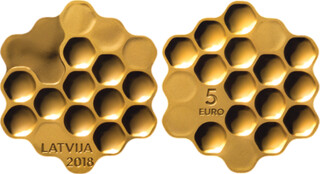 Let's see if I have this right:
Let's see if I have this right:
Create an object such as a work of art like a small sculpture, preferably round.
Since it cannot be spent at the store to buy anything that way, you slap a denomination on it.
Then you call it a "coin".
What's next? Engrave a denomination on the forehead of a small statue of Lincoln or the Queen or SBA so you can sell it to coin collectors?
What happened to the days when they actually judged "coins?"
When did we lose the word "circulating" in the judging?
For clarification on the Coin of the Year rules, I reached out to Thomas Michael of Numismatic News. -Editor
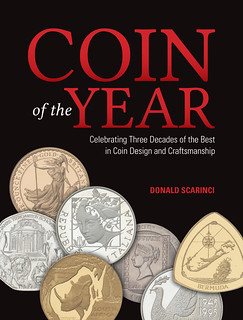 Any legal tender coin is acceptable for Coin of the Year nomination. This has been true for all 37 years of COTY competition. When a government authorizes a coin in any shape, style or
composition, be it for circulation or not, it is still a coin.
Any legal tender coin is acceptable for Coin of the Year nomination. This has been true for all 37 years of COTY competition. When a government authorizes a coin in any shape, style or
composition, be it for circulation or not, it is still a coin.
Creating a small piece of sculpture, slapping on a denomination and calling it a coin, as your writer mentions, would produce a fantasy piece, ineligible for COTY competition.
The basic criticism in this letter rests in the notion that only circulating coins are actual coins. This ignores all non-circulating legal tender coinage, which eliminates the vast majority of commemorative issues.
Coin of the Year provides criteria for nominating and judging in ten specific categories. One of the ten categories is for Best Circulating Coinage. Another, Best Bi-Metallic Coinage often contains many circulating coins.
Many of the other categories relate to commemorative themes such as Most Historically Significant, Best Contemporary, Most Artistic and Most Inspirational, any of which can contain circulating types alongside coins produced in precious metals.
Of the remaining four categories; Best Gold and Best Silver obviously host non-circulating coins. The Best Crown category centers on a diameter range and the Most Innovative category seeks to give recognition to technological and stylistic developments in coin production.
The goal of the COTY program is to honor and encourage outstanding coin design and marketing efforts worldwide. We hope these awards spark creativity, imagination and significant development in coin production and promotion.
Thanks for clarifying the rules, and that they have not changed over the years (although the categories have evolved). Many collectors rail against the use of the word "coin" for anything other than a circulating piece issued by a government and used in daily commerce. I personally would have no problem labeling most NCLT as medals. But language is by nature fluid and imprecise. I once railed myself whenever the U.S. cent was referred to as a "penny". I've thrown in the towel on that fight. Everyone knows what is meant. Someday nothing like traditional coins will be used in commerce but I suspect the word will continue to live on, as will COTY in some shape and form.
Below is a bit of the history of COTY from the Numismatic News web site. See also the earlier E-Sylum articles on Don Scarinci's 2015 book, Coin of the Year. -Editor
Coin of the Year, an award for excellence in coinage design first issued in 1984 by Krause Publications in Iola, Wisconsin, has become the ultimate international recognition of mints and their artists, growing into the community's most coveted award for contemporary world coins.
Today, artists and mints worldwide openly compete for one of the Krause Coin of the Year categories. The announcement of the Coin of the Year is one of the highlights of the annual World Money Fair and the winner in internationally celebrated. any remaining mintage of the winner quickly sells out and coin values rise dramatically on the secondary market. this is, indeed, solid evidence of the global acceptance, standing and success of the annual award.
The Coin of the Year award had a humble origin as a pet project of Krause Publications' founder Chester “Chet” Krause and former Krause Publications' President and CEO Clifford “Cliff” Mishler. by highlighting medallic art with merit, Mishler hoped to encourage world mints to improve the art of coins. Few could have imagined how the brainchild of these two pioneering men would be so well received today.
An international panel of judges nominates and votes for coins in each category. Category winners then compete for the grand price – the Krause Coin of the Year.
For more Coin of the Year news, see: https://www.numismaticnews.net/category/coin-of-the-year-news
To read the earlier E-Sylum articles, see:
NEW BOOK: COIN OF THE YEAR (https://www.coinbooks.org/esylum_v18n05a05.html)
BOOK REVIEW: COIN OF THE YEAR' (https://www.coinbooks.org/esylum_v18n30a08.html)
LATVIA HONEY COIN NAMED COIN OF THE YEAR WINNER (https://www.coinbooks.org/v23/esylum_v23n05a27.html)
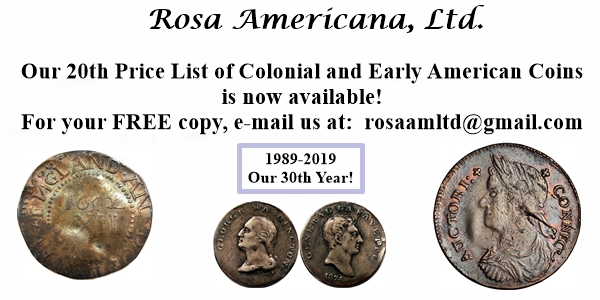
VOCABULARY TERM: HUBBING PRESS
Dick Johnson submitted this entry from his Encyclopedia of Coin and Medal Terminology. Thanks. -Editor
Hubbing Press. A press of tremendous power, used to duplicate a design in metal from a hard master to a soft steel block. Also called multiplying press, such a press is employed to duplicate dies by forcing two steel blocks into each other, called a squeeze. One steel block contains the design to be reproduced, it is hardened.
The other steel block has been prepared to receive the design by: (1) smoothing the top and bottom, making the two surfaces absolutely parallel, (2) machining a cone or dome on the top, (3) polishing smooth the cone or dome surface to receive the design, and (4) by annealing the steel until die body is dead soft. The hub and the prepared die block are placed within a hubbing retainer, a collar to hold the two in correct alignment during the squeeze.
Early screw presses were employed to do basic hubbing and continued to be used for nearly 400 years. In the 19th century specialized screw presses were built to do only hubbing by making heavier frames, longer cross beams and counterweights for greater leverage. In the 20th century hubbing presses have seen their greatest improvement, with greater pressure by hydraulic power and compressed oil or water in a closed chamber providing the powerful force.
History of hubbing presses. Very primitive hubbing occurred by forging a hard steel into a soft steel with a heavy hammer blow; this was how hubbing was use until the early 16th century. Undoubtedly when the first screw presses was developed (about 1506) the same press used for striking would also be used for hubbing (if the screw press operator could exert enough pressure). The U.S. Mint accomplished this by removing the feed and ejection mechanisms of the steam powered press to do the hubbing.
Manual screw presses were used from the 16th century even up to the 20th century. However once the collar and ejection system, or the automatic feed and delivery mechanism were installed into the screw press for striking (both developed about 1790), the press used for striking was no longer available for hubbing. Thus mints required separate screw presses, the largest and strongest was reserved for hubbing, all others for coining. The Royal Mint, London, developed a specialized screw press used only for hubbing in the early 1850s.
Hubbing requires two to three times the pressure used to strike coins, but this was accomplished by man power. Two stout men were required on opposite ends of a balance beam, by pressing on the beam and walking in a circle around the press drove the shank downward (by spindle threads). The hub and die blank were pressed into each other to effect the squeeze. Hubbing presses were made of heavy frames, with longer beams and counterweights added to gain more leverage.
It was only when hubbing presses became hydraulic (and operated by electricity after 1890) that manually operated hubbing presses with screw mechanism were replaced, although the British Royal Mint had an electrified screw press in the 1950s and 1960s which it used for hubbing.
Modern hubbing press characteristics. The modern hubbing press contains a bed, two shanks, and a gauge to indicate the power derived by the hydraulic force. Hubbing presses for coin and medal die hubbing range from 300 to 1000 tons pressure per square inch.
The time in which the squeeze occurs (closing speed) is important – slower is better – and modern presses have been improved to control not only the closing speed but also to control a longer dwel when the shanks are fully extended (this allows more flow time for surface movement). Also modern hubbing presses control initial impact, pressing speeds, pressure, thickness and depth penetration.
Specialized hubbing presses can also be either upstroke or downstroke – the direction in which the power is derived. A lever turns on/off the hydraulic valve; when turned on the hydraulic power forces the two shanks, one with the bed containing the hub and die, together. Modern presses have the hubbing occur behind a glass door. The glass is bulletproof. Hubs and dies could break during hubbing and they sometimes explode in all directions. Should such die shrapnel hit a person it is powerful enough to kill.
Thus hubbing presses are quite dangerous and are operated only by trained pressmen. Every precaution is taken that the hubbing be accomplished by safe techniques.
References:
C66 {1988} Cooper pp [early] 159-165, [modern] 235.
O37 {1977} Julian.
Looking for the meaning of a numismatic word, or the description of a term? Try the Newman Numismatic Portal's Numismatic Dictionary at: https://nnp.wustl.edu/library/dictionary
Or if you would like a printed copy of the complete Encyclopedia, it is available. There are 1,854 terms, on 678 pages, in The Encyclopedia of Coin and Medal Technology. Even running two a week would require more than 19 years to publish them all. If you would like an advance draft of this vital reference work it may be obtained from the author for your check of $50 sent postpaid. Dick Johnson, 139 Thompson Drive, Torrington, CT 06790.
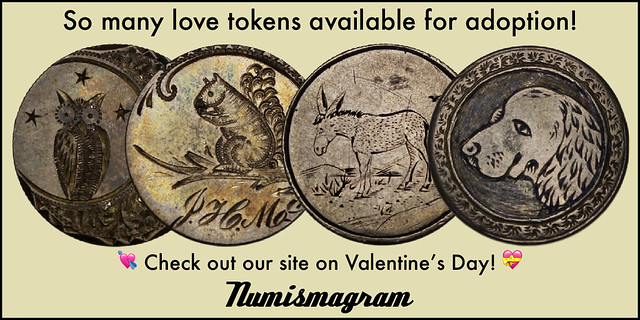
GEORGE HILLIARD DAVIS (1836-1868)
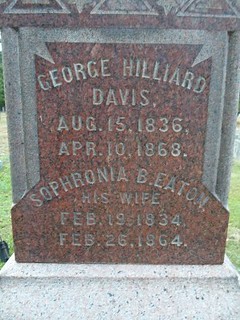 George Hilliard Davis (1836-1868), grandson of General Aquila Davis (1760-1835).
George Hilliard Davis (1836-1868), grandson of General Aquila Davis (1760-1835).
Davis began collecting coins in the 1840's. Among them his 1793 Chain Cent mentioned in a letter by Gitchell is the only coin known in his collection.
Davis was friends with John C. Gitchell and shared numismatic discussions about early American copper issues including Colonial Washington Cents, Large Cents and Half Cents. He received a letter from Gitchell dated June 18, 1857 (q. v.) about his Fugio Cent, which, before Montroville Wilson Dickeson (1810-1862) published his : The American Numismatical Manual (1859), was sometimes called a Ring Cent.
On July 1, 1863, he married Sophronia B. Eaton (1834-1864), daughter of Dr. Leonard Eaton of Warner, New Hampshire.
To read the complete article, see:
DAVIS, GEORGE HILLIARD
(https://sites.google.com/a/numismaticmall.com/www/numismaticmall-com/davis-george-hilliard)
COIN-BUYING IN THE 1950S AND 60S
Dave Lange submitted these notes and images of some interesting numismatic ephemera from the mid-20th century coin boom. -Editor
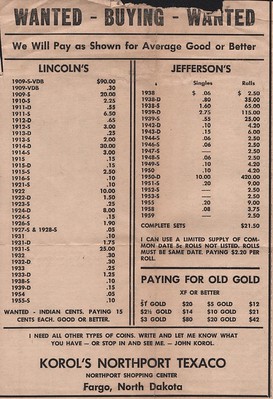 I find all sorts of newspaper clippings about coins tucked inside old coin catalogs and premium guides. This one is particularly amusing, as the owner of a Texaco station is advertising his
buying prices for coins. It's not dated, but a photo of two women on the other side shows fashions of about 1963.
I find all sorts of newspaper clippings about coins tucked inside old coin catalogs and premium guides. This one is particularly amusing, as the owner of a Texaco station is advertising his
buying prices for coins. It's not dated, but a photo of two women on the other side shows fashions of about 1963.
Here's something more I pulled off the shelf.
The United States Rare Coin Value Guide was a premium book or "prices paid" catalog that was published for many years. As is evident from the photos, this publication was a stock item with a standard cover that left room for custom printing of a dealership name. There's no publication statement inside, so I don't know who was actually behind this enterprise. It could have been Lee Hewitt, as the materials and graphics are quite similar to the self-covered reprints he produced of serial articles from his Numismatic Scrapbook Magazine.
Here are photos showing the book as it appeared during the 1950s (1804 dollar cover) and 1960s (1909-S VDB cover). The only way to date specific copies is by where the mintages for current series end.
Thanks, Dave. I've accumulated a number of these buying guides myself over the years, as I'm sure many of us have. It would be a never-ending series to collect and catalog, but always something new and interesting. -Editor
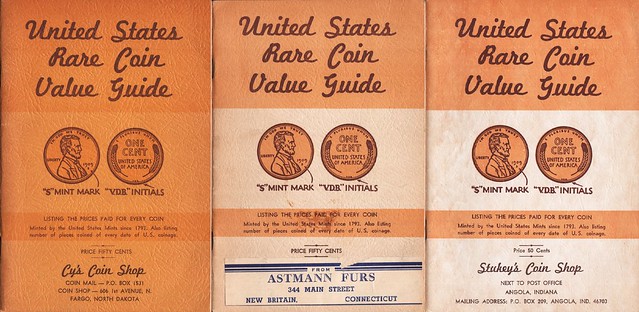
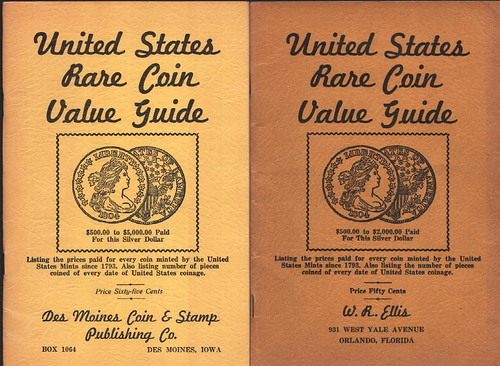
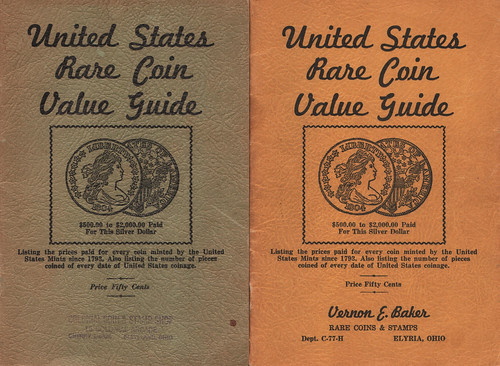

JOHN THANE'S 1786 FREDERICK SALE INVOICE
So what did coin buying look like in the 18th century? Check out this note about a recent numismatic literature acquisition submitted by Steve Hill of Sovereign Rarities. Thanks! -Editor
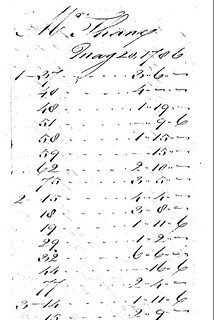
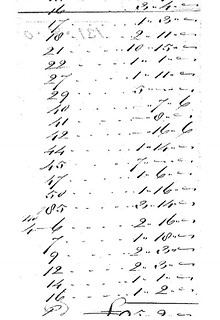
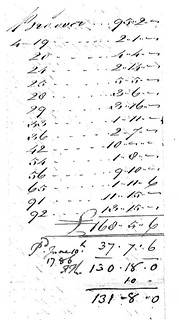
I recently bought for the Sovereign Rarities library here, an amazing bound volume of 18th Century British auction catalogues from your advertiser Douglas Saville of the 1785-88 period. They are sales that were held by the auctioneer Gerard at his house in Litchfield Street, St Anne's, Soho in London.
Tucked inside the front of the sale of “The Entire and Very Valuable Museum of the Late Sir Charles Frederick” held on 17th May 1786 until 20th May 1786 is the original auction bill for John Thane (c.1747-1818) whose own major sales of coins took place after his death.
I attach herewith a scan of the two sided auction bill dated 20th May 1786 which totals an amazing £131 and 8 Shillings with full breakdown of the lots and money paid to add up to this total. 52 lots purchased over the four days of activity.
I have never seen an original auction bill to purchase coins from the late 18th Century and I thought fun to share with your readership.
I see from Manville's biographical dictionary that Sir Charles Frederick (1709-85) was a politician and antiquary. Comptroller of the Ordnance and Fireworks, known for his collection of Anglo Gallic coins (20 gold and 53 silver) - from which Thane purchased some pieces on this bill.
John Thane was a London agent-dealer, printseller and engraver in Soho and married to Thomas Snelling's daughter, later selling Snelling's collection post mortem to Samuel Tyssen.
NATIONAL NUMISMATIC COLLECTION DIGITIZATION
Anne Bentley of the Massachusetts Historical Society passed along a tweet from the Smithsonian with an update on digitization efforts at the National Numismatic Collection. -Editor
"Pssst! Have you noticed approx. 10,000 coins from our @SmithsonianDPO project with the National Numismatic Collection @amhistorymuseum are already online? The entirety of the Josiah K. Lilly Jr. & Paul A. Straub collections have been digitized and are making their way online"
To read the complete tweet, see:
https://twitter.com/SIxDIGI/status/1224353656847208451
The Collection's web page has more information on recent efforts. -Editor
Recent digitization initiatives
Mass Digitization Project: Coins and Medals of the Lilly, Straub, and Mikhailovich Collections
The National Numismatic Collection is partnering with the Smithsonian Digitization Program Office to digitize over 26,000 coins and medals from the Josiah K. Lilly Jr., Paul A. Straub, and Grand Duke Georgii Mikhailovich collections. This project received additional funding from the National Collections Program. These images will be available online by mid-2020.
West African Currency Digitization Project
The National Numismatic Collection partnered with the London School of Economics (LSE) to digitize 880 West African currency objects. This project was generously funded by the LSE's Knowledge Exchange and Impact Fund.
- Access the collection in the museum's online catalog
- Access the project's Learning Lab
- Access a description of the project here
Numismatics 3D Digitization Pilot
The Smithsonian Digitization Program Office's 3D team partnered with the National Numismatic Collection to digitize and create online educational experiences for a collection of East Asian coins. Browse the models here or find them through Learning Lab.
German Notgeld Inventory
The National Numismatic Collection has completed a one year project to catalog and create digital surrogates of a collection of approximately 6,000 German notgeld notes. This project received Federal support from the Smithsonian Collections Care and Preservation Fund, administered by the National Collections Program and the Smithsonian Collections Advisory Committee.
Cataloging and Digitizing Chinese Paper Money
The National Numismatic Collection has completed a two year project, generously funded by Michael Chou, to catalog and digitize approximately 5,800 pieces of Chinese paper money. Images of these objects are available on the Smithsonian's Collections Search Center and a portion are on the Smithsonian's Transcription Center website, where digital volunteers all over the world will be able to assist with the transcription and transliteration of these notes.
Howard F. Bowker East Asian Coin Project
The National Numismatic Collection completed a two year project to digitize over 8,000 coins in its East Asian coin collection thanks to a generous donation from the Howard F. Bowker Family and Michael Chou. A dedicated member of staff cataloged and photographed these coins and related monetary objects that span nearly three thousand years of East Asian history. The collection is publicly accessible via the Smithsonian's online catalog.
John Adams Comitia Americana Medals Project
The National Numismatic Collection completed the digitization of its Comitia Americana medals thanks to a generous donation from John Adams. A dedicated member of staff cataloged and facilitated the photography of 119 medals struck between 1776 and the late 19th century. This group of historic medals represent a newly independent United States engaging with the international community through numismatic art.
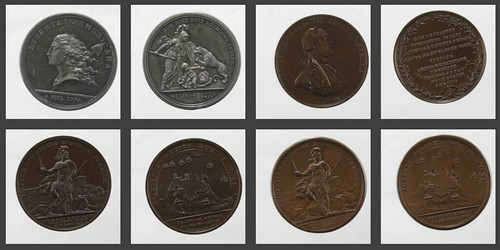
I'm very glad to learn that these efforts have been progressing. -Editor
To read the complete article, see:
Recent digitization initiatives (https://americanhistory.si.edu/national-numismatic-collection/collection)
THE BOOK BAZARRE
ANA SEMINAR ON WILLIAM AND CHARLES BARBER
The February 2020 issue of The E-Gobrecht (a publication of the Liberty Seated Collectors Club) featured this article calling for students to register for the upcoming ANA Summer Seminar course on William and Charles Barber. -Editor
Register now for “The Legacy and Coinage of Father-Son Mint Engravers William and Charles Barber” at the ANA Summer Seminar, June 29-July 2!
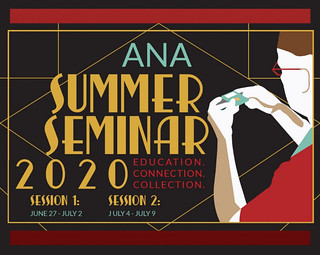 With all of the recent publicity and interest regarding the engravers William and Charles Barber, Glenn Holsonbake and John Frost will be offering a class at the 2020 Summer Seminar at the
American Numismatic Association (ANA) in Colorado Springs entitled, The Legacy and Coinage of Father-Son Mint Engravers William and Charles Barber. The course will be offered during Session 1, June
29-July 2. This course will explore the history and coinage designed by 5th and 6th Chief Mint Engravers, William Barber (1869-1879) and Charles Barber (1880-1917). This hands-on class will study in
detail all 6 circulation coin series bridging from the late 19th into the early 20th century. This includes William Barber's Trade dollars and twenty-cent pieces, along with Charles Barber's Liberty
nickels, Barber dimes, quarters and half dollars.
With all of the recent publicity and interest regarding the engravers William and Charles Barber, Glenn Holsonbake and John Frost will be offering a class at the 2020 Summer Seminar at the
American Numismatic Association (ANA) in Colorado Springs entitled, The Legacy and Coinage of Father-Son Mint Engravers William and Charles Barber. The course will be offered during Session 1, June
29-July 2. This course will explore the history and coinage designed by 5th and 6th Chief Mint Engravers, William Barber (1869-1879) and Charles Barber (1880-1917). This hands-on class will study in
detail all 6 circulation coin series bridging from the late 19th into the early 20th century. This includes William Barber's Trade dollars and twenty-cent pieces, along with Charles Barber's Liberty
nickels, Barber dimes, quarters and half dollars.
In addition, we will explore the patterns and mint medals created by these prolific engravers, along with their designs of commemoratives and coins of other countries that were made under contract with the U.S. Mint. Seminar #11: The Legacy and Coinage of Father-Son Mint Engravers William and Charles Barber.
The course is limited to 15 students, so register early!
The Summer Seminar catalog is available on the ANA website at www.money.org/summer-seminar.
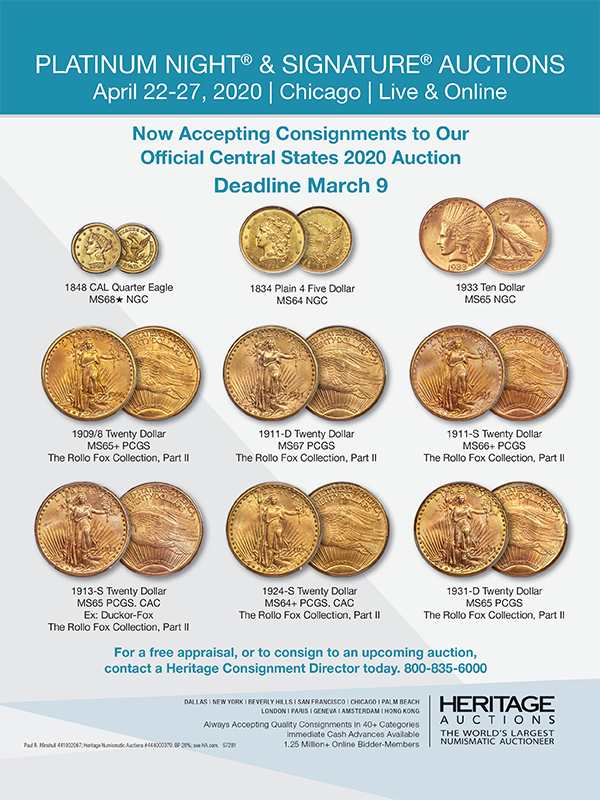
MORE HOLABIRD FEBRUARY 2020 SELECTIONS
Here are additional numismatic items that caught my eye in the upcoming Holabird sale. -Editor
Lot 3211: Hall, Dame & Bullock Shell Card
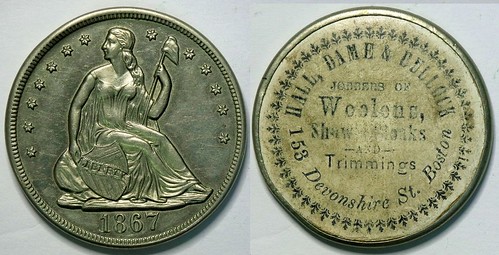
Obverse: Resembles $1 U.S. Silver Dollar, 1867
Reverse: Hall, Dame & Bullock/Jobbers of/Woolens/Shawls, Cloaks/And/Trimmings/153 Devonshire St. Boston/38mm.
Maker: T.N. HIckcox & Co.
Ref: Bower's pg. 115
Provenance: John Reynolds Collection
I've never collected shell cards, but they are quite varied and interesting, with many coin-like designs. -Editor
To read the complete lot description, see:
3211 SHELL CARD / B-MA-260 / MA, / Hall, Dame & Bullock/ $1- 1867A
(111470) (https://holabirdamericana.liveauctiongroup.com/SHELL-CARD-B-MA-260-MA-Hall-Dame-Bullock-1-1867A-111470_i35647180)
Lot 3221: J.W. Ackerman Shell Card
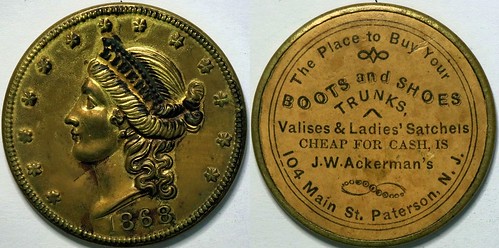
Potentially unique.
Obverse: $20- 1868 (Resembles $20 U.S. Gold Piece), emb. metal.
Reverse: The Place to buy Your/Boots and Shoes/Trunks,/Valises & Ladies Satchels/Cheap For Cash, Is/J.W. Ackerman's/104 Main St. Paterson, N.J./Yellow cardboard/34mm.
Listed, but not pictured in Bowers.
To read the complete lot description, see:
3221 SHELL CARD / B-NJ-660/ NJ, Paterson / J.W. Ackerman / $20- 1868
(111512) (https://holabirdamericana.liveauctiongroup.com/SHELL-CARD-B-NJ-660-NJ-Paterson-J-W-Ackerman-20-1868-111512_i35647190)
Lot 3344: 1932 Olympiad Souvenir Gold Fractional Token
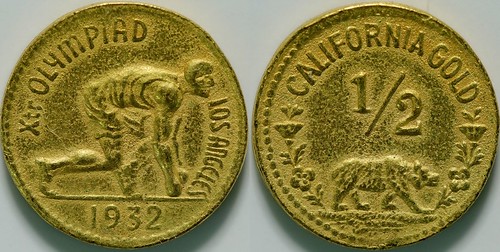
On the front. "X Olympiad Los Angeles 1932, with runner pictured in the blocks.
On the back. "California Gold 1/2" measures 12 mm
Provenance: John Reynolds Collection
Neat little Olympic piece. -Editor
To read the complete lot description, see:
3344 1932 Olympiad Souvenir Gold Fractional Token (111539)
(https://holabirdamericana.liveauctiongroup.com/1932-Olympiad-Souvenir-Gold-Fractional-Token-111539_i35647313)
Lot 3346: House of Murphy Store Card
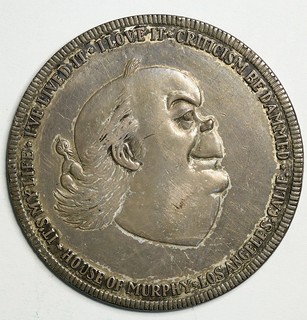
Uniface House of Murphy store card. Reverse stamped STERLING at bottom edge. It's my life. I've lived it. I love it. Criticism be damned. 38mm. Silver. AU
Provenance: John Reynolds Collection
A real "in your face" piece. Check out the bird nesting in his long hair. Anyone know more of the story about this Los Angeles item? -Editor
To read the complete lot description, see:
3346 House of Murphy Store Card (114066)
(https://holabirdamericana.liveauctiongroup.com/House-of-Murphy-Store-Card-114066_i35647315)
Lot 3512: H. Miller Die Sinkers Store Card
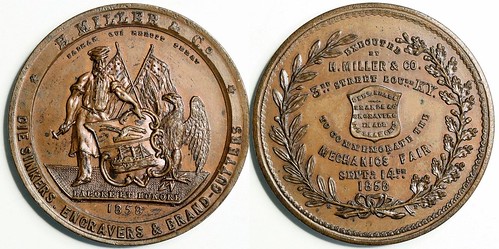
Obverse design of mechanic, eagle, American flags, and shield. 33mm. Copper. Rulau Ky 24. Unc.
Provenance: John Reynolds Collection
To read the complete lot description, see:
3512 H. Miller & Co. Die Sinkers Store Card (114118)
(https://holabirdamericana.liveauctiongroup.com/H-Miller-Co-Die-Sinkers-Store-Card-114118_i35647481)
Lot 3514: Joseph Merriam Die Sinker Store Card
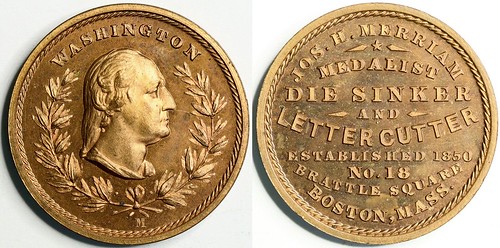
Joseph Merriam's die sinker store card, Washington right in wreath obverse. 27.1mm. Brass. Musante GW-685. Gen Unc
Provenance: John Reynolds Collection
Great numismatic Americana and Washingtoniana as well. Nice piece. -Editor
To read the complete lot description, see:
3514 Joseph Merriam Die Sinker Store Card (114119)
(https://holabirdamericana.liveauctiongroup.com/Joseph-Merriam-Die-Sinker-Store-Card-114119_i35647483)
Lot 3564: Iron County Wood Scrip
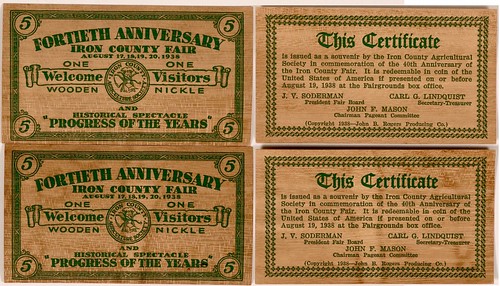
Two total. Fortieth Anniversary Iron County Fair, 1938. "One Wooden Nickle, "Welcome Visitors", "5" in each corner. Seal of Iron County Agriculture Society center. Reverse certificate of issue. John B. Rogers printer. Excellent condition.
Provenance: John Reynolds Collection
Just one example of the wooden scrip and wooden nickels in the sale. -Editor
To read the complete lot description, see:
3564 Iron County Wood Scrip. (112460)
(https://holabirdamericana.liveauctiongroup.com/Iron-County-Wood-Scrip-112460_i35647533)
Lot 3599: Apollo Space Flight Medal Dies
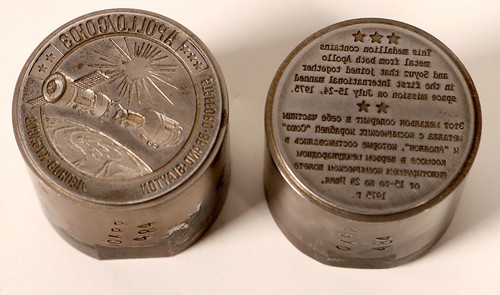
1975 and a die from the Russia-USA docking event. From the Northwest Territorial Mint Historical Die Collection. dollar size
See the sale for a wide selection of cool token and medal dies. -Editor
To read the complete lot description, see:
3599 Apollo Space Flight Medal Dies (2) (112161)
(https://holabirdamericana.liveauctiongroup.com/Apollo-Space-Flight-Medal-Dies-2-112161_i35647568)
To read the earlier E-Sylum article, see:
SELECTIONS FROM HOLABIRD FEBRUARY 2020 SALES (https://www.coinbooks.org/v23/esylum_v23n05a24.html)
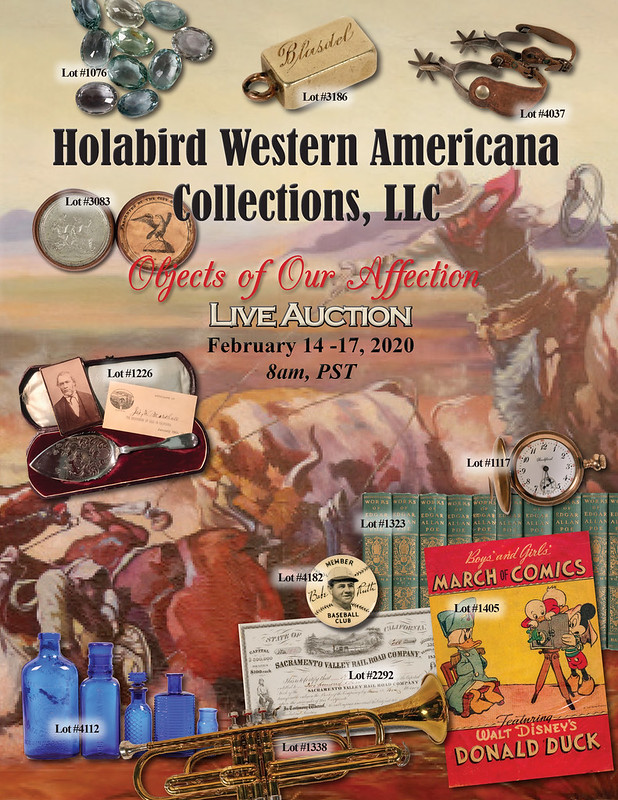
ARCHIVES INTERNATIONAL SALE #57 SELECTIONS
Here some items that caught my eye in the upcoming Archives International sale. -Editor
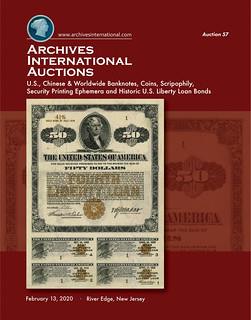
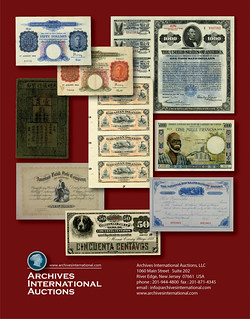
Lot 166: 1790 Copenhagen Exchange and Mortgage Bank Note
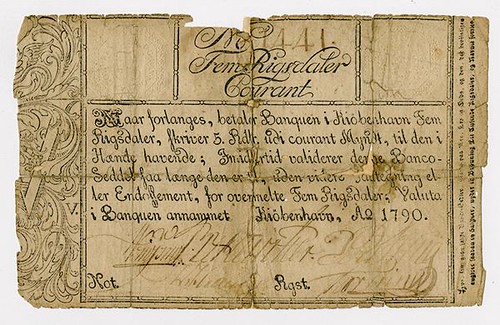
Copenhagen, Denmark, 1790, 5 Rigsdaler Courant, P-A29a, Issued banknote, anti-counterfeiting text added vertically at right, On white paper, blank back, S/N 1441, Good to VG with what appears to be contemporary reinforced splitting horizontally and vertically on the back, a small hole in the right middle where reinforced and small tears in the lower margin, otherwise in very presentable example of this rare note. Only 2 previous auction appearance over the last 7 years.
To read the complete lot description, see:
166 Copenhagen Notes, Exchange and Mortgage Bank, 1790 Banknote.
(https://auction.archivesinternational.com/Copenhagen-Notes-Exchange-and-Mortgage-Bank-1790-Banknote_i35684548)
Lot 252: Guadeloupen 500 Francs
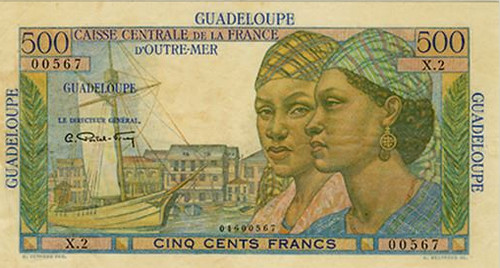
Guadeloupe. Issued 500 Francs, ND (1947-1949), P-36. PMG graded Very Fine 30 (Cert # 5003608-007).
To read the complete lot description, see:
252 Caisse Centrale de la France d'Outre-Mer. ND (1947-1949).
Issued Banknote. (https://auction.archivesinternational.com/Caisse-Centrale-de-la-France-d-Outre-Mer-ND-1947-1949-Issued-Banknote_i35684634)
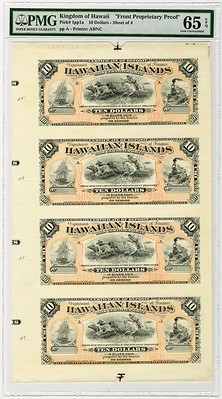
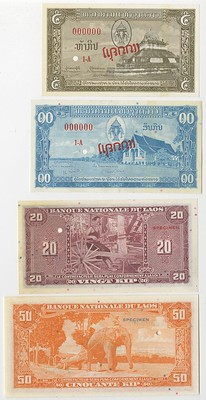
Lots 303 and 304
Lot 303: 1879 Hawaii Silver Certificate of Deposit
Kingdom of Hawaii, 1879 (1880) Proprietary Proof Reprinted from original plates ca.1960-70), Uncut vertical sheet of 4 notes, $10, P-1 Unlisted as a Proprietary Proof face, no back, Partial
counterfoil on left attached and cut close to note, Black on light orange underprint, Sailing ship on left, locomotive on right, and cowboy roping steers at center, large margins, printed on thin
white card with guideline markings, PMG graded Gem Uncirculated 65 EPQ. ABNC. Extremely rare if not unique as an uncut proof sheet.
To read the complete lot description, see:
303 Kingdom of Hawaii, Department of
Finance, 1879 (1880) Silver Certificate of Deposit, Uncut Sheet of
(https://auction.archivesinternational.com/Kingdom-of-Hawaii-Department-of-Finance-1879-1880-Silver-Certificate-of-Deposit-Uncut-Sheet-of_i35684685)
Lot 304: 1957 Banque Nationale de Laos Specimen Banknotes
Laos. Lot includes 5, 10, 20, and 50 Kip, ND (1957), P-2s, P-3s, P-4s, & P-5s. All appear Choice to Gem Unc with POCs but there is evidence of previous light mounting. SBNC.
To read the complete lot description, see:
304 Banque Nationale de Laos. 1957. Quartet of Specimen Banknotes.
(https://auction.archivesinternational.com/Banque-Nationale-de-Laos-1957-Quartet-of-Specimen-Banknotes_i35684686)
Lot 394: 1918 Tsaritsyn Self Government Temporary Credit Note
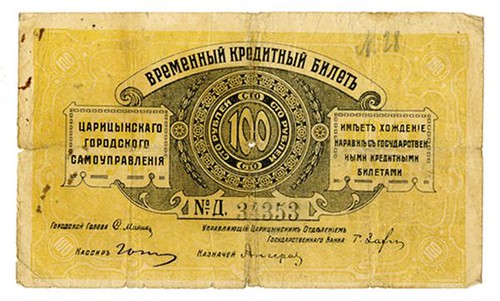
Russia - Southwest, issued 100 Rubles, local issue of the town of Tsaritsyn in the Volgograd region, not listed in the Standard Catalog, About Fine condition.
World banknotes are a wide open collecting field - so much to learn. I'd never seen a note like this before. -Editor
To read the complete lot description, see:
394 Tsaritsyn Self Government, Volgograd,
Russia - Southwest, ca. 1918, Issued Temporary Credit Note
(https://auction.archivesinternational.com/Tsaritsyn-Self-Government-Volgograd-Russia-Southwest-ca-1918-Issued-Temporary-Credit-Note_i35684776)
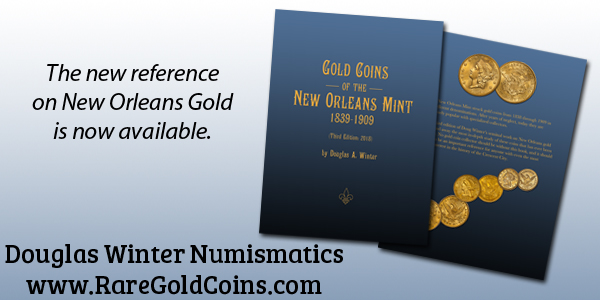
GROUVILLE HOARD SETS WORLD RECORD
David Sundman forwarded this story about the Grouville Hoard found on the island of Jersey in 2012. -Editor
David writes:
"We've covered the find in the past, but now we know the total size. Quite amazing. I just wish Jersey was as close as New Jersey, as this is certainly worth a museum visit."
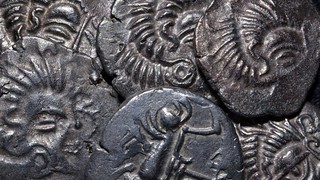 A hoard of Iron Age coins worth an estimated £10 million has been officially recognised as the largest of its kind to be recovered in the British Isles.
A hoard of Iron Age coins worth an estimated £10 million has been officially recognised as the largest of its kind to be recovered in the British Isles.
Reg Mead and Richard Miles, both metal detectorists, discovered the Celtic coins in Jersey in 2012 after a 30-year search.
The final number of coins found in the collection has now been confirmed as 69,347, setting a Guinness World Record. The find surpasses the previous record for the largest collection of Iron Age coins of 54,951 found more than 40 years ago in Wiltshire.
Some of the treasure is now on display at La Hougue Bie Museum, in the Jersey parish of Grouville.
Olga Finch, curator of archaeology for Jersey Heritage, said: “We are not surprised at this achievement and are delighted that such an impressive archaeological item was discovered, examined and displayed in Jersey.”
Mr Mead and Mr Miles found the coins after spending decades searching in a field. They had received a tip-off in the 1980s from a woman who said she had spotted something that looked like silver buttons.
The hoard is thought to date from about 50BC and was discovered at a depth of only 3ft. The Roman and Celtic silver and gold coins were entombed under a hedge in a large mound of clay weighing three quarters of a tonne.
To read the complete article, see:
Record coin hoard found after 30-year hunt in field
(https://www.thetimes.co.uk/article/record-coin-hoard-found-after-30-year-hunt-in-field-wq550krvf)
To read earlier E-Sylum articles, see:
MASSIVE COIN HOARD UNEARTHED IN JERSEY (https://www.coinbooks.org/esylum_v15n28a27.html)
JERSEY GROUVILLE HOARD BEING DISMANTLED (https://www.coinbooks.org/esylum_v17n35a32.html)
JERSEY GROUVILLE HOARD WAS TWO COLLECTIONS (https://www.coinbooks.org/v22/esylum_v22n12a24.html)
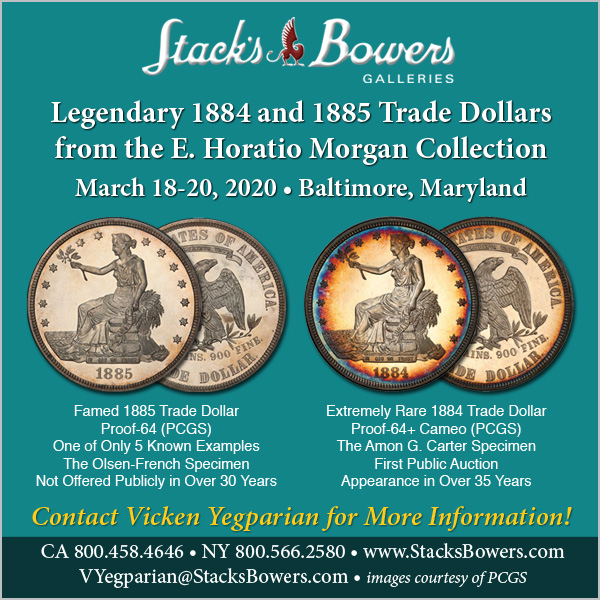
MUSEUM RECOGNISES DETECTORIST CONTRIBUTIONS
David Sundman also forwarded this story about recognition of the contribution of metal detectorists to knowledge of ancient Rome. Thanks. -Editor
David writes:
"This is an interesting overview of metal detectorist activity in Great Britain and the impact they've made, with much of the roman finds being coins."
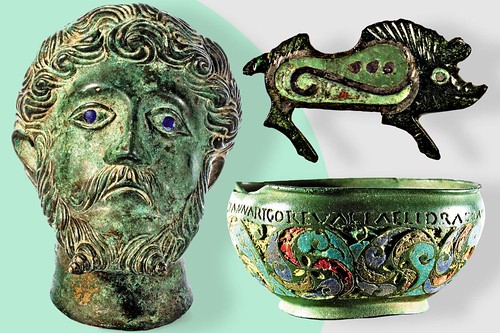
They have been derided as cultural vandals or nerds in army surplus who spend hours in frozen fields to find only ring-pulls from beer cans.
Now, however, metal detectorists have been recognised by the British Museum as having transformed knowledge of Roman Britain by finding and reporting the vast majority of more than half a million artefacts, leading to the identification of 1,000 new sites.
The museum said that Roman finds account for more than a third of the 1.48 million artefacts in the database of the Portable Antiquities Scheme (PAS), launched in 1997. This is a voluntary programme it runs to document objects found by the public that would otherwise go unrecorded. Most finds do not have to be declared under the Treasure Act, which applies to precious metal finds and coin hoards.
Experts said the “sheer abundance” and diversity of Roman finds compared with those of other periods up to the scheme's cut-off date of 1650 is a sign of the fundamental changes in Britain under Roman rule, from AD43 to about 410.
The discoveries have revealed more than 1,000 Roman sites in England and Wales, often in places where archaeologists were not looking. While the objects include artworks, inscribed bronze tablets and military equipment, many sites have been identified by clusters of low-value coins that are individually unremarkable.
More than 320,000 of all the Roman finds are coins, including scores of types that were not previously known. “By looking at the chronological profiles of coin finds in different regions, we see enormous variation in coin use,” Mr Moorhead said. These reflect the varying extent of Roman military and economic activity in different places.
A new book highlights the 50 most interesting finds from the scheme, from a bronze bust of Marcus Aurelius to a figure of an African slave boy. The artefacts in the book 50 Roman Finds from the Portable Antiquities Scheme by John Pearce and Sally Worrell, from Amberley Publishing, show both exotic new influences in Britain and objects in hybrid Roman-British styles demonstrating continuity with local pre-Roman cultures.
The scheme's database of almost 1.5 million finds is the largest of its kind and its database of Roman coins the largest single numismatic dataset in the world.
To read the complete article, see:
Detectorists helped us find Roman Britain
(https://www.thetimes.co.uk/article/detectorists-helped-us-find-roman-britain-g6wn3cqdp)
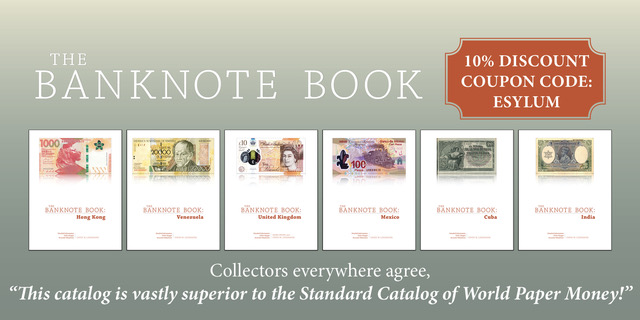
A 1795 SILVER-PLUGGED HALF DOLLAR
Senior Numismatist James McCartney published a Stack's Bowers Galleries blog article about a rare silver-plugged 1795 half dollar will featured in the firm's March 2020 Baltimore Auction. Nice coin. -Editor
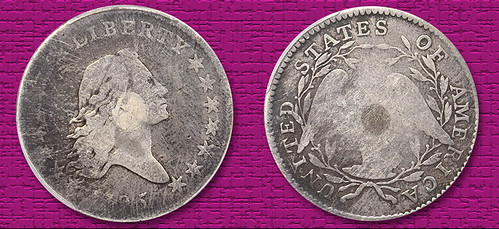
The early United States Mint practice of inserting silver plugs into half dollars and dollars to regulate their weights is perhaps one of the most romanticized techniques used to produce America's first coinage. It recalls an era of handcrafted workmanship and motivates today's collectors to examine their Flowing Hair coinage in the hopes of uncovering one of these surprises.
We are delighted to offer an important silver-plugged 1795 O-130 half dollar in our March 2020 Official Auction of the Whitman Coin & Collectibles Spring Expo in Baltimore. Recently certified for the first time at Good-6 (PCGS), it has been held in a private collection for two decades and is now appearing on the market for the first time in a generation.
This piece owes its existence to the difficulties faced by the early United States Mint in producing high quality planchets at the correct weight and fineness. In 1795, half dollars and other silver coins were made only at the specific denomination requests of depositors. Metal was refined, strips rolled out, and planchets made at the Mint, often slightly overweight so that they could be trimmed by filing. If they had attempted to achieve a precise weight, a generous portion would have been underweight and would have had to have been corrected. As it was, some were indeed underweight, as here. Mint employees used the silver plugging technique as a means of bringing underweight planchets up to standard. This process was not without precedent, having been used in other world mints at that time.
This experiment was first noted on 1795 Flowing Hair silver dollars, publicized after research conducted by Kenneth W. Bressett, Q. David Bowers and Roger W. Burdette. After continued study by specialists, that denomination appears to have been the primary target of the practice, as the vast majority of silver plug U.S. Mint coins are silver dollars. Most of these are 1795 Flowing Hair dollars, although the unique 1794 silver dollar with a silver plug (the celebrated Carter-Cardinal-Morelan specimen) points to an earlier attempt.
The silver plug technique was used far less often with half dollars. Surviving examples of this denomination are exceedingly rare and eagerly sought. In fact, we are aware of only four silver plug half dollars that are positively confirmed to exist, all of which are dated 1795.
The present example is the first silver plug half dollar that we have offered since our 2015 Baltimore Auction, where we sold an example from the 1795 O-128 dies for $49,937. Incredibly, an example of this type was missing from our November 2019 sale of the nearly-complete E. Horatio Morgan Collection of Half Dollar Varieties. The piece presented in our upcoming March auction was last offered in Sheridan Downey's Mail Bid Sale #24 of November 1999 and has resided in a private collection for the past two decades.
To read the complete article, see:
Rare Silver Plug 1795 Half Dollar Featured in our March 2020 Baltimore Auction
(https://www.stacksbowers.com/News/Pages/Blogs.aspx?ArticleID=1795-silver-plug-march-2020)
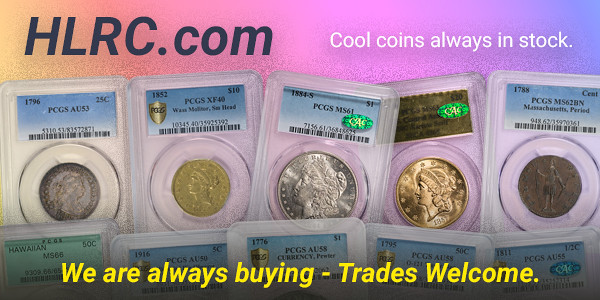
INTERNATIONAL YEAR OF DISABLED PERSONS COINS
In his Blind Coin Collector blog February 1, 2020, Tom Babinszki wrote about the International Year of Disabled Persons series, featuring coins from the Isle of Man. With permission, we're republishing it here. Thanks, Tom. I wasn't aware of this series. -Editor
In 1981, the Isle of Man released four 1 Crown coins celebrating the international Year of Disabled Persons (IYDP). With this, they issued almost ten percent of the entire series. Though the coins are identical in measurement, they represent a diverse history and are unique in many ways.
Before we look at the coins, it is important to put the Isle of Man into a greater perspective to understand the diversity of coins.
The head of state is the Queen of the United Kingdom, holding the title of Lord of Mann, but the isle has retained self-governance. It is not part of the European Union, but according to the Treaty of Rome, it is part of the EU's customs area. This means that the Isle of Man is part of the Brexit negotiation.
The Isle of Man is located in the Irish Sea, has the size of 221 square miles, and according to the 2016 census has a population of 83314 people. One of the island's main revenue is tourism.
The currency on the Isle of Man is the Manx Pound, but the Pound Sterling is also accepted as a secondary currency. The value of one Manx Pound is exactly one Pound Sterling. The Manx Pound is not recognized as legal tender in the United Kingdom.
Just like on many small islands, one source of income is the sale of commemorative coins, which explains the higher ratio of IYDP coins. Until 2016 the coins were minted at the Pobjoy Mint, but since 2017 at the Tower Mint. The coinage of the Isle of Man are quite collectable, they often change the design on the circulating coins and issue many commemoratives. According to Numista, at the time of this writing, there are 1136 coins listed under the Isle of Man.
After this unfairly brief introduction, let's look at the IYDP coins. While the circulating coins are the Pound which is 100 Pence, all four IYPD coins are of the value of 1 Crown, and they are all considered to be commemorative issues.
All four coins are dated 1981 and have the exact same features: 28.47 g weight, 38.61 mm diameter, made of copper-nickel, and the thickness is not
As there is very little information out there about this series, I have contacted the Pobjoy Mint for more information. The only thing they were able to produce from 1981 is a brochure of the coins, though I did find out that it is not an accident that the coin designers are not listed. Interestingly, many of the Pobjoy Mint's coins are not designed by one person only, rather it is more of a staff effort.
The text on all four coins say “International Year of the Disabled”, which is probably due to design consideration, but because of this the “International Year of Disabled Persons” is often, incorrectly being referred to, particularly in numismatic literature as the “International Year of the Disabled”.
The four coins commemorate the following people:
- Louis Braille
- Ludwig van Beethoven
- Sir Douglas Bader
- Sir Francis Chichester
The four people represent different types of disabilities, and also different contributions to the life of people with disabilities. Let's look at the coins one by one.
Louis Braille 1 Crown
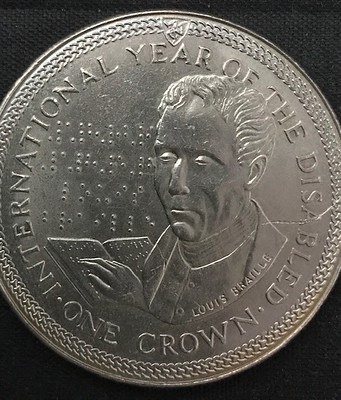
Most likely Louis Braille needs very little introduction, he has been one of the most influential figures impacting the life of people with disabilities. Braille lived between 1809 and 1852. He invented a writing system for blind people, named braille after him, and is still used today. The word braille, referring to the writing system is often spelled with a capital “B”, my understanding is that when it refers to the writing system it is spelled with a lower-case “b”. There is an extensive literature about Louis Braille, and there is nothing I can add in the context of this writing, so I would encourage you to find information about him on the internet or in your library.
What is not so widely known though, is that this was the first commemorative coin in history which contained braille writing. The first circulation coin containing braille was the Italian 500 Lire from 1982. It is worth noting that the braille script on the 1 crown coin is not for blind people to feel, rather for awareness purposes. Braille script is also not used in a conventional way. A braille number consists of letters from “a” to “j”, with a number sign in front to indicate that it is a number. The number sign should appear only once, but on the coin each number is preceded by a number sign. On the other hand, capital sign is not used in front of the name of Louis Braille.
Braille letters are much larger than printed letters simply because a similarly small font cannot be accurately felt by touch. Therefore, a small printed book would be several volumes in braille.
For the sake of comparison, on the following picture you can see the coin itself, with the same braille script side by site with regular size braille characters, which can be read by blind people.
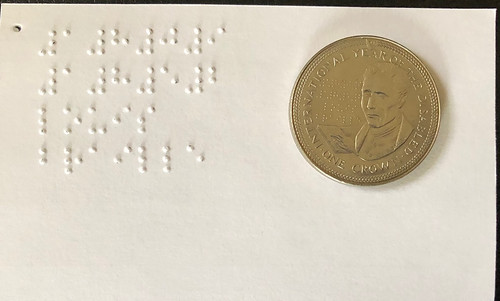
Ludwig van Beethoven 1 Crown
Beethoven also doesn't need an introduction. The reason why he is related to people with disabilities is because at the end of his life he lost his hearing, and he was almost completely deaf when he
composed one of his most popular pieces, the ninth symphony. At the first performance of the symphony, he was not able to hear any of it. When we talk about people with disabilities, Beethoven is not
the first person who comes to mind, but his legacy has much more to say in present days. As the life expectancy is higher today than in his time. Today, the majority of people with disabilities
acquired their disability due to aging. Where his example is important today is that disability does not mean that people have to live a lesser life, rather, with the necessary changes in doing daily
activities people can continue living an equally fulfilling life. For that matter, all four people on this coin series were born without a disability.
Sir Douglas Bader
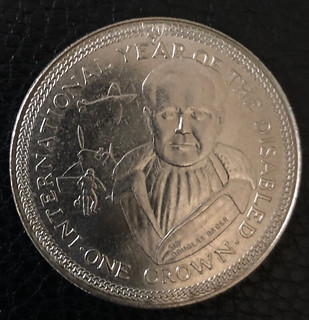
Sir Douglas Bader is the only one of the four people featured in this series who was on a coin during his lifetime, though he died in 1982 a year after the coin was issued.
When we look at the Sir Douglas Bader 1 Crown, it is certainly not disability what comes to mind first. The coin has two airplanes, a man is just getting into one, who is Sir Douglas Bader.
Bader joined the Royal Air Force, but at the age of 21, in 1931, both of his legs had to be amputated due to an accident. Though he was almost ready to give up his dream of flying when the Second World War broke out, and due to the shortage of pilots he was allowed to join the Air Force again. From this time of his life, he was probably best known about the Duxford Wing, a formation of five squadrons.
After the war he worked as an executive at Royal Dutch Shell and also spent time visiting and supporting injured servicemen. He was knighted in 1976 for his service to amputees, and died in 1982. He is an example of how to continue living a fulfilling life with a disability, which at his age was much more difficult than it is today.
Continuing his legacy, his grandson Charley Bickers created Britain's first air-display team with only disabled people. The BBC created a short video about it, it is absolutely worth watching.
To watch the BBC video, see: Meet the UK's first disabled air display team - BBC Stories (https://www.youtube.com/watch?v=drN4HaBM5hA)
Sir Francis Chichester 1 Crown
Sir Francis Chichester was also a pilot, but this is not the reason why he was featured in this series. On the coin there is a boat beside him, and the reason is that he was the first person to
circumnavigate the globe alone with one stop in 1966-67. For a while I didn't quite understand why he was featured on a coin, but after thinking about it more, it was probably one of the best
decisions to feature a large segment of disabilities. When we talk about disabilities, we tend to think about visible disabilities, or at least more severe, life changing ones. In reality, most
people will experience some form of disability, temporary or permanent in a lifetime. Sir Francis Chichester started losing his vision and he had to stop flying in the 1940's. He was born in 1901, so
the loss of his vision is hard to attribute to aging though it could be a part of it. But this is exactly what we need to understand when we talk about disabilities, some are due to aging, and some
disabilities are only minor, but large enough to change one's life. Chichester definitely needed to find another interest, which became sailing that didn't require perfect vision. Out of the four
people, it is probably most difficult to find information about him, especially regarding his disability.
To read the complete article, see:
IYDP coins of the Isle of Man (https://blindcoincollector.com/2020/02/01/iydp-coins-of-the-isle-of-man/)

ROYAL MINT ISSUES NEW FIVE KILO GOLD COIN
Wales Online published a story about the Royal Mint's whopping new £5,000 coin. -Editor
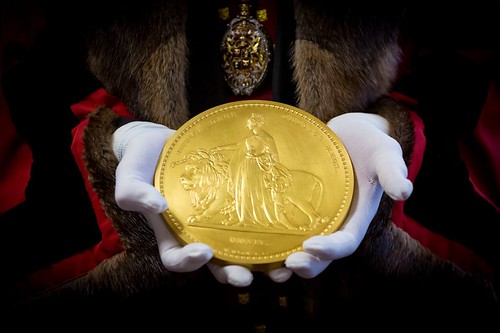
A gold coin that weighs around five kilos and is worth more than most people's homes has been unveiled by the Royal Mint.
The face value of the coin is £5,000 - but it's actual worth is thought to be a staggering £300,000.
It features the Una and The Lion design, conceived in 1839 by William Wyon, former official chief engraver at the Royal Mint.
A £2,000 coin weighing two kilos and reportedly worth nearly £120,000 has also been made by the Llantrisant based coin producer.
Both coins are made 999 fine gold and has been remastered from an original die used almost 200 years ago.
They both form part of a new Great Engravers series to celebrate the finest artists who have worked on British coins.
To read the complete article, see:
Royal Mint unveils gold coin worth £300,000 that weighs five kilos
(https://www.walesonline.co.uk/affiliates/royal-mint-5000-coin-llantrisant-17685978)

PHIL MICKELSON'S GOLF BALL MARKER
W. David Perkins of Centennial, CO passed along this Golf Digest article on Phil Mickelson's numismatic ball marker, and a new token issued by the Pebble Beach tournament's host organization. Thanks. -Editor
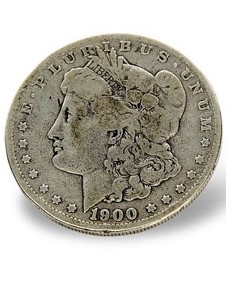 The Morgan silver dollar is worn as smooth as polished marble, which isn't surprising given its age. Circa 1900. Yeah, it's 120 years old, and its silver content, just over three-quarters
of an ounce, has a melt value of roughly $13.50. In mint condition, the coin is worth about $31.
The Morgan silver dollar is worn as smooth as polished marble, which isn't surprising given its age. Circa 1900. Yeah, it's 120 years old, and its silver content, just over three-quarters
of an ounce, has a melt value of roughly $13.50. In mint condition, the coin is worth about $31.
This coin, which Phil Mickelson cherishes about as much as anything he owns, is not mint. Not even close. The year is barely legible. But it represents warm memories, a singular euphoric moment, and an important piece of his family's heritage.
Which, rather significantly, is conjoined with Pebble Beach Golf Links, where on Thursday Mickelson begins his title defense in the AT&T Pebble Beach Pro-Am. A five-time winner here, Mickelson received the coin from his maternal grandfather, Al Santos, in 2003, a few months before he passed away at age 97. His grandfather, not skilled but not afraid to work and sweat, was one of the original caddies at Pebble Beach when it opened in 1919.
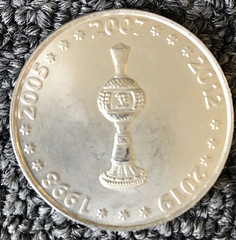 In tribute to Mickelson's five wins at Pebble Beach, including his three-stroke win last year that brought his PGA Tour victory total to 44, the tournament's host organization, the Monterey
Peninsula Foundation, had a silver coin made that has been presented to each of the 156 amateurs in the field.
In tribute to Mickelson's five wins at Pebble Beach, including his three-stroke win last year that brought his PGA Tour victory total to 44, the tournament's host organization, the Monterey
Peninsula Foundation, had a silver coin made that has been presented to each of the 156 amateurs in the field.
On one side of the coin is the tournament trophy and the dates of Mickelson's five wins—1998, 2005, '07, '12 and '19. On the other side is the tournament logo. Steve John, CEO of Monterey Peninsula Foundation, said the coin “pays tribute to Mickelson as well as a legion of caddies who have played a key role in the past 100 years of golf at Pebble Beach.”
To read the complete article, see:
How Pebble Beach is paying homage to Phil Mickelson, his grandfather and a very special silver dollar
(https://sports.yahoo.com/pebble-beach-paying-homage-phil-121115271.html)
To read the earlier E-Sylum article, see:
THE NUMISMATICS OF GOLF (https://www.coinbooks.org/v21/esylum_v21n14a27.html)
15TH AMENDMENT BLACK SUFFRAGE MEDAL
Last week researcher John Kraljevich posted a great article on Facebook about the City of Charleston Free Badge. In keeping with the Black History Month theme, on February 3rd he published a piece about the 15th Amendment and a medal commemorating it. Here's an excerpt. -Editor
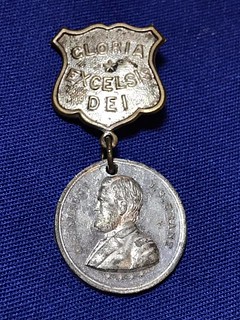
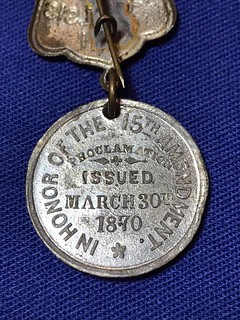
On February 3, 1870, the United States Constitution was amended to guarantee the right to vote to all male Americans, with no restrictions “on account of race, color, or previous condition of servitude.”
This was the last of three Reconstruction Amendments that sought to give African-Americans full access to American citizenship and civil rights. It was passed by a Congress that included zero African-Americans. After the passage of the 15th Amendment, African-Americans were elected to Congress from the states of South Carolina, Georgia, Alabama, Florida, Mississippi, North Carolina, and Louisiana between 1871 and 1883.
President Grant ardently protected African-American suffrage, sending the 7th Cavalry into York County, South Carolina (where I live) in 1871 to put down a Klan rebellion that sought to keep black men from the polls. After Reconstruction ended, and Federal protections of 15th Amendment rights were no longer present, Southern states instituted Jim Crow laws intent to keep African-Americans from voting. These laws, and the campaigns of terror that accompanied them, were successful. By 1896, legal disenfranchisement reduced black voting by 90% across the South. In 1940, only 3% of African Americans in the South were registered to vote. Decades of activism, lawsuits, and Federal intervention led to the passage of the Voting Rights Act of 1965.
This medal celebrates the passage of the 15th Amendment, using the March 30, 1870 date when the amendment's ratification was proclaimed. The Latin Gloria Excelsis Dei translates to “the highest glory to God.” This pin could have been worn by an African-American or a white ally in the fight for black suffrage. It is extremely rare today.
To read the complete article, see:
https://www.facebook.com/john.kraljevich/posts/10222080837709785
To read the earlier E-Sylum article, see:
THE CITY OF CHARLESTON FREE BADGE (https://www.coinbooks.org/v23/esylum_v23n05a31.html)

GEORGE MEDAL FOR SAVING PRINCESS ANNE
Dix Noonan Webb is selling the George Medal given to passerby Ronnie Russell for helping save Princess Anne in a 1974 London attack. Thanks to Dick Hanscom for passing along this BBC News article. -Editor
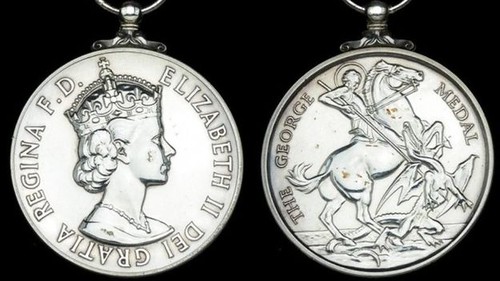
A medal awarded to a boxer who helped save the Princess Royal from an attempted armed kidnap is to be sold.
Former heavyweight Ronnie Russell, 72, punched Ian Ball in the head as he tried to abduct the princess at gunpoint in London in 1974.
Mr Russell was awarded the George Medal for bravery by the Queen, who told him: "The medal is from the Queen, but I want to thank you as Anne's mother."
It is expected to fetch between £15,000 and £20,000 at auction next month.
Mr Russell, who now lives in Bristol, said he was selling due to ill health and wanted to provide for his future.
Mr Russell was heading home to Kent when he thwarted the late-night ambush.
Ian Ball had blocked the princess's car on The Mall in central London and had fired shots, wounding four people.
"It was very fast moving," Mr Russell said.
He said Ball was trying to drag Princess Anne from her car while her then husband, Captain Mark Phillips, was pulling her back.
"She was very, very together, telling him: 'Just go away and don't be such a silly man'," he said.
"He stood there glaring at me with the gun and I hit him. I hit him as hard as I could and he was flat on the floor face down."
Ball was later sent to a psychiatric hospital by an Old Bailey judge.
To read the complete article, see:
George Medal for saving Princess Anne from kidnap up for sale (https://www.bbc.com/news/uk-england-bristol-51383434)
A MING NOTE WITH HISTORICAL PROVENANCE
The Stack's Bowers Galleries blog highlights an interesting Ming Dynasty note with a documented provenance to 1888, when it was one of the first examples in the U.S. and among the first known to collectors anywhere. -Editor
In our 10 Year Anniversary Sale at the Mira Hotel in Hong Kong, we will be once again be offering a few Ming Dynasty notes in various conditions. However, one note will stand out from the group, but not for the typical reasons like vermillion overprints or bold impressions.
While the note may be extensively circulated with minor paper repairs and visible paper loss, it accompanied by a story that propels its desirability well beyond the typical example. Understanding why however, requires insight of the modern history of this note. These notes were once great rarities, but two modern finds have supplied interested collectors with the opportunity to own what would otherwise seem destined for a museum. the first was a bundle found in 1900 by forces intervening in the Boxer Rebellion; the second find occured in 1936 as one of the walls that surrounded Beijing was being torn down, The note we offer in our upcoming Hong Kong auction, however is one of the few notes known that predate those finds, and is likely the only example outside of a museum with the accompanying documentation to prove it!
Dated November 19, 1888, the first letter accompanying this note reads:
Mr. C. F. Gunther,
Dear Sir:
I had the pleasure of visiting your museum in July last and examining your very extensive and interesting collection. You were away from home when I passed through Chicago.
I have recently received in a consignment of antiques from Shanghai, a most rare and curious specimen of early paper money belonging to the Ming dynasty (14th Century), which is probably the oldest issue of paper money extant. Only a few specimens are known; one of these is the specimen in the Imperial Museum at St. Petersburg Russia. This has been figured by several authors on Chinese money. My specimen is undoubtedly authentic and is in a good state of preservation being about 500 years old. Some fragments across the central fold are missing but the note is nevertheless a good specimen, and probably (almost certainly) there is no other in America. The note is 13 inches long by 8-1/2 in. wide. It is interesting as being probably the oldest paper money known and as showing the printing of the Chinese probably 500 years ago. This specimen considering its great rarity should be worth $50. As I am not speculating, however, I will let you have it for $20. I sent to China four years ago to a collector for one of these notes. He has only just found one. Since writing him I have sold my collection of paper money and therefore give you the first chance to secure the specimen at a low figure. I shall be glad to send it to you for inspection.
Yours very truly,
Edwin A. Barber
Mr. Gunther, made wealthy by his success in the candy business, obviously couldn't turn down the opportunity to add this intriguing historical artifact to his museum. This museum, among other things, came to hold such American relics as Abraham Lincoln's deathbed and the table that Robert E. Lee used to sign the Confederate surrender documents at the Appomattox Court House. After Gunther's passing in 1920, the Chicago Historical Society would buy his collection in whole for $150,000. It later became the foundation for what is today known as the Chicago History Museum.
To read the complete article, see:
A Ming Note with Historical Provenance
(https://www.stacksbowers.com/News/Pages/Blogs.aspx?ArticleID=ming-note-history)
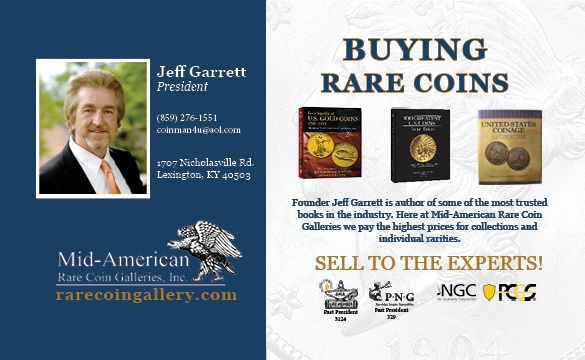
BRISTOL POUND ON THE BRINK OF CLOSURE
Here are excerpts from two articles on the Bristol Pound alternative currency found via the February 4, 2020 issue of News & Notes from the Society of Paper Money Collectors. -Editor
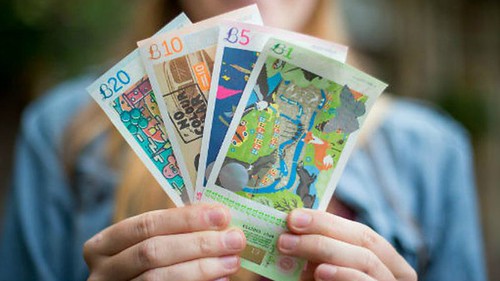
Community currency the Bristol Pound could close next month unless it receives grant funding.
New Start has reported on Bristol Pound since its inception in 2012 when it was heralded as Bristol's ‘local economic incubator'. However, the community interest company (CIC) behind the currency says it is now increasingly difficult to raise grant funding to support the venture.
The concept behind Bristol Pound was a local paper currency that can be distributed and spent locally, which keeps money circulating within a geographical location and away from the pockets of shareholders of large corporations or bankers. It can be spent at 800 businesses in the city, you can pay your council tax with it, and famously the former mayor had his salary paid in the currency.
Bristol Pound had been the most high profile community currency in the UK and the model inspired other fledging currencies such as Bourn Coin, which have also struggled to become financially sustainable.
Bristol Pound CIC says all money currently held in the currency is safe until September 30, 2021.
To read the complete article, see:
Bristol Pound on the brink of closure
(https://newstartmag.co.uk/articles/bristol-pound-on-the-brink-of-closure/)
A leading economist has slammed Bristol's local currency, which looks to be on the brink of closure.
Christopher Snowdon, head of lifestyle economics at the Institute for Economic Affairs, said that the “only obvious beneficiaries of the Bristol Pound are the people who run the project”.
He said that local currencies like the Bristol Pound “confuse wealth with money – and make their areas poorer as a result”.
The Bristol Pound recently revealed that it needs £100,000 to cover its running costs, with its digital scheme ceasing to exist from April if no further funding is found.
This is “economic insanity” according to Snowdon. “Far from being a boost to the local economy, the Bristol Pound has more likely been a drain on it…
“Dig beneath the surface and the Bristol Pound looks less like a radical experiment to grow the economy and more like another taxpayer-funded make-work scheme for people with fashionable opinions.”
Snowdon may have written that the Bristol Pound confuses wealth with money, but its managing director Diana Finch has hit back, saying that he has confused cost with value.
Finch said: “Snowdon has fundamentally misunderstood the aims of the Bristol Pound. The primary aim was to encourage people and businesses to spend their money with independent businesses local to the region rather than large national and multi-national corporates.
“The reason is that local independent businesses are focused on serving the needs of the community. They also provide employment for local people that is unlikely to relocate to elsewhere at the whim of some corporate investment decision.
To read the complete article, see:
‘THE BRISTOL POUND IS ECONOMIC INSANITY'
(https://www.bristol247.com/business/news-business/the-bristol-pound-is-economic-insanity/)
A HANDMADE BOOKSHELF
Bibliophiles will appreciate this story of a New Orleans woman's quest for the perfect bookshelf. Here's an excerpt, but be sure to read the complete article online. -Editor
Four years ago, I bought my single shotgun house in New Orleans, not just because I wanted to live in this beloved city but also for the house's aesthetics: excellent light, high ceilings, hardwood floors. Also, there was a four-and-a-half-foot wide space lodged between a more than 100-year-old brick fireplace and a wall of the living room that sang to me. It was in this spot where I instantly visualized that which did not yet exist: a floor-to-ceiling custom bookshelf.
As an author and lover of books, bookshelves have always acted as kinds of altars for me, even as they serve a functional purpose. Still, I'd never had a fancy bookshelf before. I'd had Ikea particle board bookshelves and hand-me-down-from-friends bookshelves and dumpster-dive bookshelves and back-of-the-thrift store bookshelves. Never had I owned something stylish and new and tailored for me and my needs. A handmade bookshelf to fit a nearly 13-foot ceiling? Frankly, it was a sex dream.
There was also the idea of it being created out of thin air. A space existed, and it needed to be filled. This appealed to me as a novelist, a person who is constantly conjuring up universes where they previously hadn't existed, even as I felt a nervous energy around the decision. It can feel risky to imagine things, perhaps even riskier to ask someone else to imagine for you, particularly in this, the first house I had ever bought, which I had saved for for years.
To read the complete article, see:
The best $1,600 I ever spent: A handmade bookshelf
(https://www.vox.com/the-goods/2020/2/4/21083866/jami-attenberg-best-money-custom-bookshelves)

LOOSE CHANGE: FEBRUARY 9, 2020
Here are some additional items in the media this week that may be of interest. -Editor
A Banknote Guide to the U.K.
David Sundman passed along this nice guide to locations connected to circulating British banknotes. Thanks! -Editor
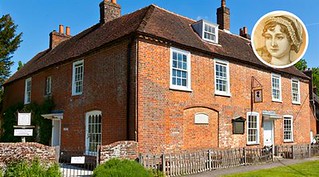 You've probably had all of them in your pocket at some point or another, but the famous faces on our British bank notes have a lot more to them than just cultural kudos. Club writer,
Hannah Ralph, takes a look at the destinations these trailblazing Brits held most dear
You've probably had all of them in your pocket at some point or another, but the famous faces on our British bank notes have a lot more to them than just cultural kudos. Club writer,
Hannah Ralph, takes a look at the destinations these trailblazing Brits held most dear
To read the complete article, see:
A BANK NOTE GUIDE TO THE UK (http://theclub.ba.com/february-2020/en/a-bank-note-guide-to-the-uk/)
Montreal British Milita Token
On his JLRC Newsletter blog, Jacob Lipson discussed a rare Canadian numismatic item: the Montreal British Milita token. -Editor
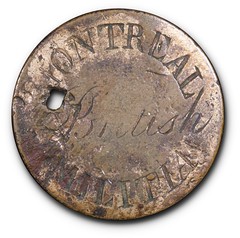 Chief among our recent buys is a fantastic Montreal British Milita token. This is one of those pieces that appears in every edition of the Charlton guide, but go try and find one on the
bourse floor. You won't find one. They come up from time to time in auctions, but they are pretty darn scarce. I spoke with one dealer recently who hadn't seen one in 15 years. I have not handled one
in the ten years I have been doing this, and as a (former) Montrealer am delighted to finally pick one up.
Chief among our recent buys is a fantastic Montreal British Milita token. This is one of those pieces that appears in every edition of the Charlton guide, but go try and find one on the
bourse floor. You won't find one. They come up from time to time in auctions, but they are pretty darn scarce. I spoke with one dealer recently who hadn't seen one in 15 years. I have not handled one
in the ten years I have been doing this, and as a (former) Montrealer am delighted to finally pick one up.
To read the complete article, see:
JLRC Is Off To A Great Year!
(https://www.jacoblipsonrarecoins.com/jlrc-blog/2020/2/5/jlrc-is-off-to-a-great-year)
Presidential Medal of Freedom Analysis
Here's an updated version of a story originally published on Nov. 16, 2018 analyzing Presidential picks for the Medal of Freedom. -Editor
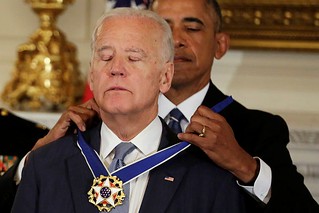 President Donald Trump awarded his 15th Presidential Medal of Freedom to conservative radio commentator Rush Limbaugh on Feb. 4.
President Donald Trump awarded his 15th Presidential Medal of Freedom to conservative radio commentator Rush Limbaugh on Feb. 4.
This award was notable for two reasons. First, it was controversial because Limbaugh is a polarizing political figure. And second, this marked the first time that any president awarded a Medal of Freedom during a State of the Union address.
Typically, Presidential Medal of Freedom ceremonies occur once or twice per year and provide Americans with an opportunity to celebrate the achievements of various people who have made an important contribution to U.S. culture. Because the president selects recipients with total discretion – American or otherwise, living or dead – this award also says a lot about the president himself.
What achievements or contributions does the president consider important? What groups of people most easily win his favor? And how does he hope to shape his legacy, judging by the company that he chooses to keep?
To find out, we've analyzed every Presidential Medal of Freedom ever awarded, and the presidents who awarded them – including Trump.
To read the complete article, see:
What Trump's picks for the Presidential Medal
of Freedom – like Rush Limbaugh and Antonin Scalia – say about him
(https://theconversation.com/what-trumps-picks-for-the-presidential-medal-of-freedom-like-rush-limbaugh-and-antonin-scalia-say-about-him-131362)
Continental Dollar Found in Junk Box
The Paris office of PCGS certified a junkbox find as a genuine Continental Dollar. Nice find! -Editor
 Grading in the Paris office for PCGS is always a thrill. The submissions in Europe always trend to yielding treasures not often seen. The last grading event in Paris left seasoned graders
blown away with one of these discoveries. In a single coin submission sat a 1776 Continental Currency Dollar, a coin that is highly treasured and not often seen. What made this coin special was it
was found in a junk box for 50 cents euro.
Grading in the Paris office for PCGS is always a thrill. The submissions in Europe always trend to yielding treasures not often seen. The last grading event in Paris left seasoned graders
blown away with one of these discoveries. In a single coin submission sat a 1776 Continental Currency Dollar, a coin that is highly treasured and not often seen. What made this coin special was it
was found in a junk box for 50 cents euro.
1776 Continental Dollars feature an obverse of three rings. The center ring design is a sundial, with the rays of the sun and text below the dial, “MIND YOUR BUSINESS.” The next ring features “FUGIO” and the sun. The last ring contains the text, “CONTINENTAL CURRENCY.” The reverse features a design of interlocking chain links around the border of the face, featuring the names of the 13 colonial states. The reverse design contains two rings, the center of two rings reads “WE ARE ONE” and the ring around the center ring reads “AMERICAN CONGRESS.” The coins have several varieties in the spelling, ornamental designs, or in metal compositions. While produced in a variety of metals, the coin was most often struck in pewter.
The intent of the Continental Dollar was originally believed to be pattern or circulation issue coinage for the continental United States to circulate alongside the banknotes that Congress had authorized and issued. However, in recent years others have argued that the coins were actually medals, made as satire by England – struck in pewter to mock the worthless value of the currency of the United States. While the origin of these pieces is still under debate, the 1776 Continental Dollars are important early coinage celebrating the birth of the brand-new nation of the United States. This iconic coin has been heavily counterfeited and many restrikes have been produced privately.
To read the complete article, see:
PCGS Paris Office Certifies 1776 Continental Dollar Found in Junk Box for 50 Cents
(https://www.pcgs.com/news/pcgs-paris-office-certifies-1776-continental-dollar)
HOARDER'S COTTAGE YIELDS £80,000 GOLD TREASURE
Everyone loves a treasure hunt. But it's never easy, even when all the treasure is within the walls of a tiny cottage. This article from The Guardian tells of an auctioneer's adventure handling an estate in Gloucestershire. -Editor
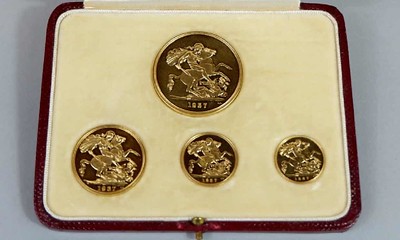 John Rolfe had no expectations of finding anything valuable when he arrived at a ramshackle two-up, two-down cottage tucked away in a remote West Country valley.
John Rolfe had no expectations of finding anything valuable when he arrived at a ramshackle two-up, two-down cottage tucked away in a remote West Country valley.
But as the auctioneer began to explore by the light of his mobile phone torch the glint of gold caught his eye. Rolfe began to turn out drawers and cupboards and found them full of valuable coins.
“It was mind-blowing. I felt like a pirate in a grotto,” he said. “There was a coin here, a coin there. If I opened a drawer there were more coins.” He even found a coin among sugar cubes in a bowl.
The most valuable lot was No 210, a 1937 specimen coin set comprising a £5 coin and sovereigns in a Morocco leather case, which sold for £8,000.
There were also coins commemorating royal occasions and historical events and figures, celebrating great artists and marking sporting events.
“When you get a call like that and hear about coins you think it's going to be a few coppers and maybe a Georgian halfpenny. If you're lucky you'll find £20- or £30-worth. I thought it was going to be as dull as dishwater.”
Rolfe drove out to the cottage on a rainy day. “There was flooding and the van only just made it there. It had steam coming out of the bonnet.,” he said.
“The cottage was in the middle of nowhere. To say the place was ramshackle doesn't quite cover it. It was damp, rat-infested. There was an old car on the drive that looked as if it had never been moved.
“The gentleman was a hoarder. We go into an lot of properties but I've never seen anything like it. You could barely get through the front door. We couldn't turn the lights on. There were boxes and boxes of paperwork floor to ceiling in every room.”
But then he saw the glinting.
“Almost every coin was in mint condition still stored in its original plastic with its receipt. I got a team down to clear the property. That was no mean feat. A normal house clearance will take a day or two. This took three weeks of four men every day.”
To read the complete article, see:
'I felt like a pirate in a grotto': gold coins found in
hoarder's cottage fetch £80,000 (https://www.theguardian.com/uk-news/2020/feb/05/gold-coins-found-in-hoarder-cottage-fetch-pounds-80000-auction-stroud)

